Majorca, Spain
Visiting Majorca: What to do in 10 days? Our itinerary.
Majorca is the main island of the Balearic Islands archipelago. This Spanish island is located in the Mediterranean Sea off the east coast of Spain. Known for its resorts, protected coves with turquoise water and its paradisiacal beaches, we ventured off the beaten path and discovered an island where nature reigns supreme. Here is our 10-day itinerary on the island of Majorca.
Our 10-day itinerary in Mallorca

We were lucky enough to have an early flight and arrive around 8:30 AM in Palma de Mallorca. Getting off the plane, the sun and heat were already there, and it felt so good after the last few gray and rainy months we had in Belgium!
After picking up the rental car, we had the whole day ahead of us to enjoy our arrival on the island.
Day 1 • Arrival in Palma & walk in Portals Vell
PALMANOVA AND ITS BEACH
Palmanova is a small resort town located in the municipality of Calvia, 20 minutes from Palma. This is where we had our 1st accommodation. We enjoyed the main beach, Palmanova Beach, both during the day and in the evening.
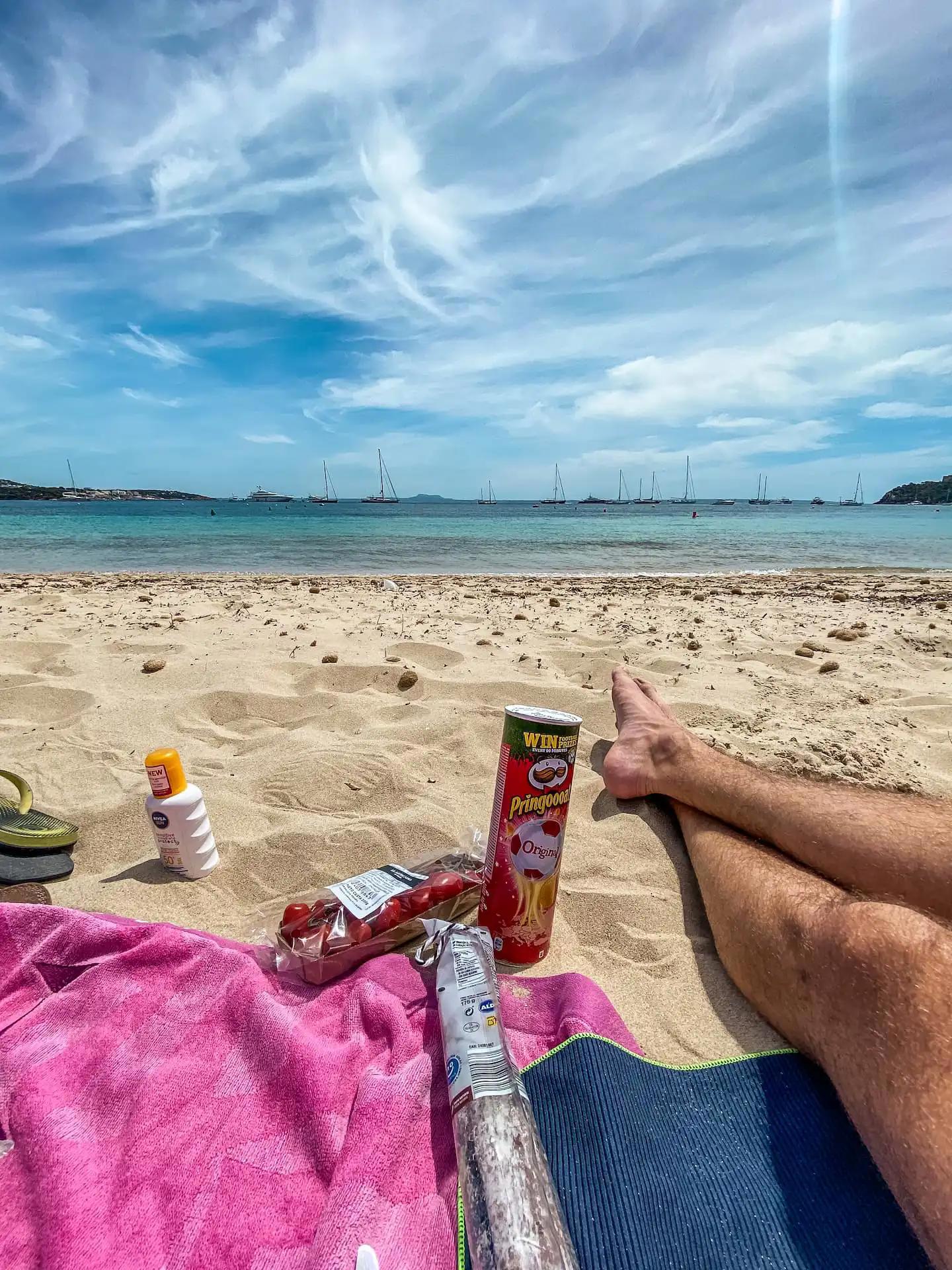
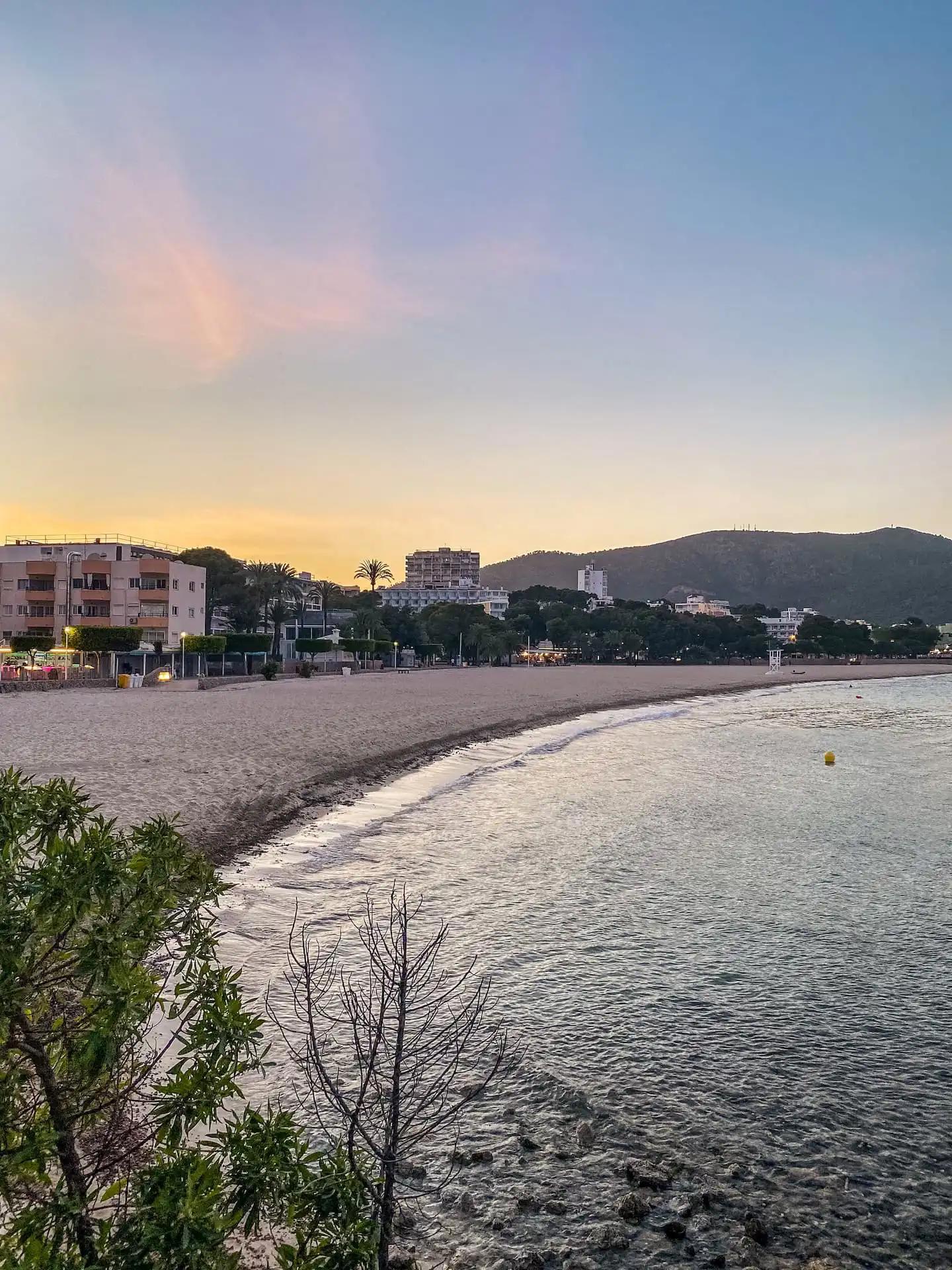
Where to eat in Palmanova?
🥗 Siso Beach : Restaurant on the seawall facing Platja de Son Maties. Don't hesitate to book to get the best seats with sea views.
🍕 Il Tano : Pizzeria on a small square in the city center. You can also take away to enjoy on the beach facing the sea.
Walk in Portals Vells: between coves, caves and cliffs
Portals Vells is known for its 3 idyllic coves where nature still reigns supreme: Plajta del Rei, Plaja del Mago, and Platgeta de Portals Vells. We arrive via a winding road that passes through pine trees. Parking is free and in two sections; we parked in the furthest one and walked down (5 mins) to Platja del Mago.
This first white sand beach with turquoise water and bordered by pine trees is a fairly well-known nudist beach on Mallorca. If you walk across it and continue your way, you'll find its little sister, Platgeta de Portals Vells, just as idyllic.
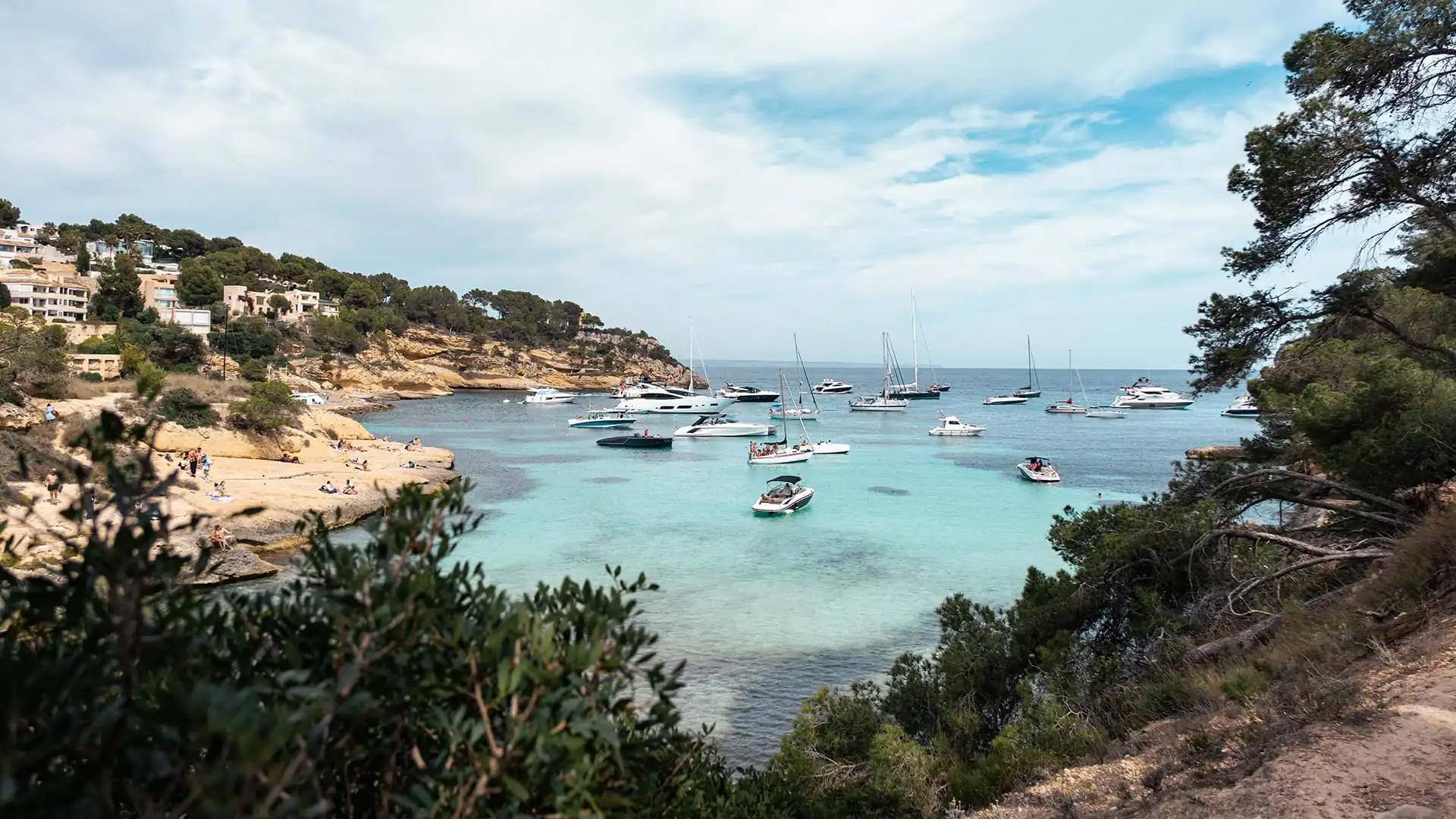
We continue our journey towards the cliffs and stumble upon the famous Portals Vells Caves. They were originally a quarry from which stone blocks were extracted in the 14th and 15th centuries to build the famous Cathedral of Palma. When venturing inside the cave, one can find inscriptions and religious carvings sculpted into the rock that refer to a fishermen's legend.
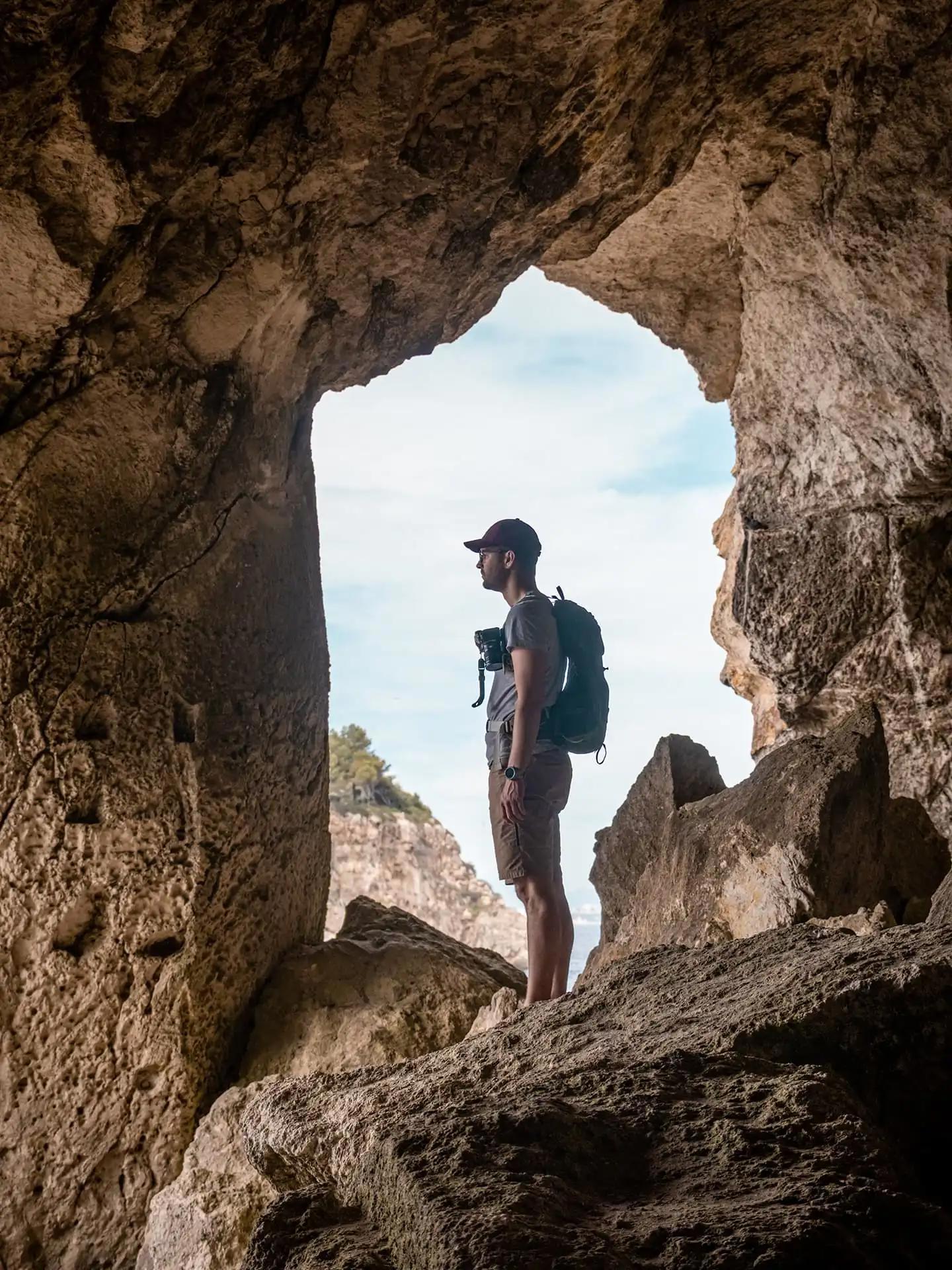
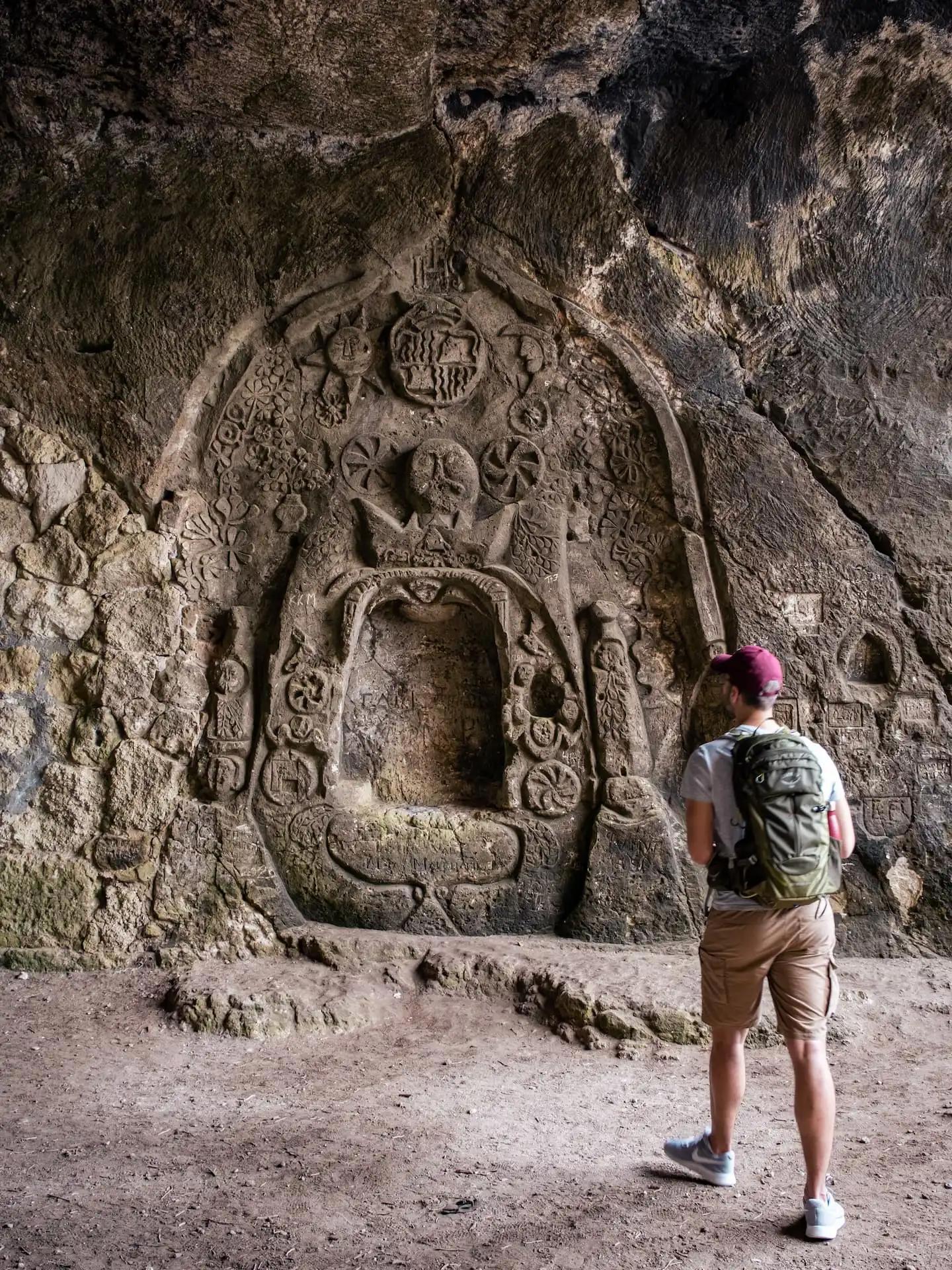
After this cooler stop in the caves, we resume our journey to the top of the cliffs. Once at the summit, it's a dense blue sea that blends with the horizon. We observe the gulls flying around us and listen to the sound of the waves crashing against the ochre-coloured cliffs. A true postcard of a wild Mallorca.
It's also a known spot for vanlife enthusiasts, 5-6 vans are parked right next to the trail and 5 minutes walk from the beaches below.
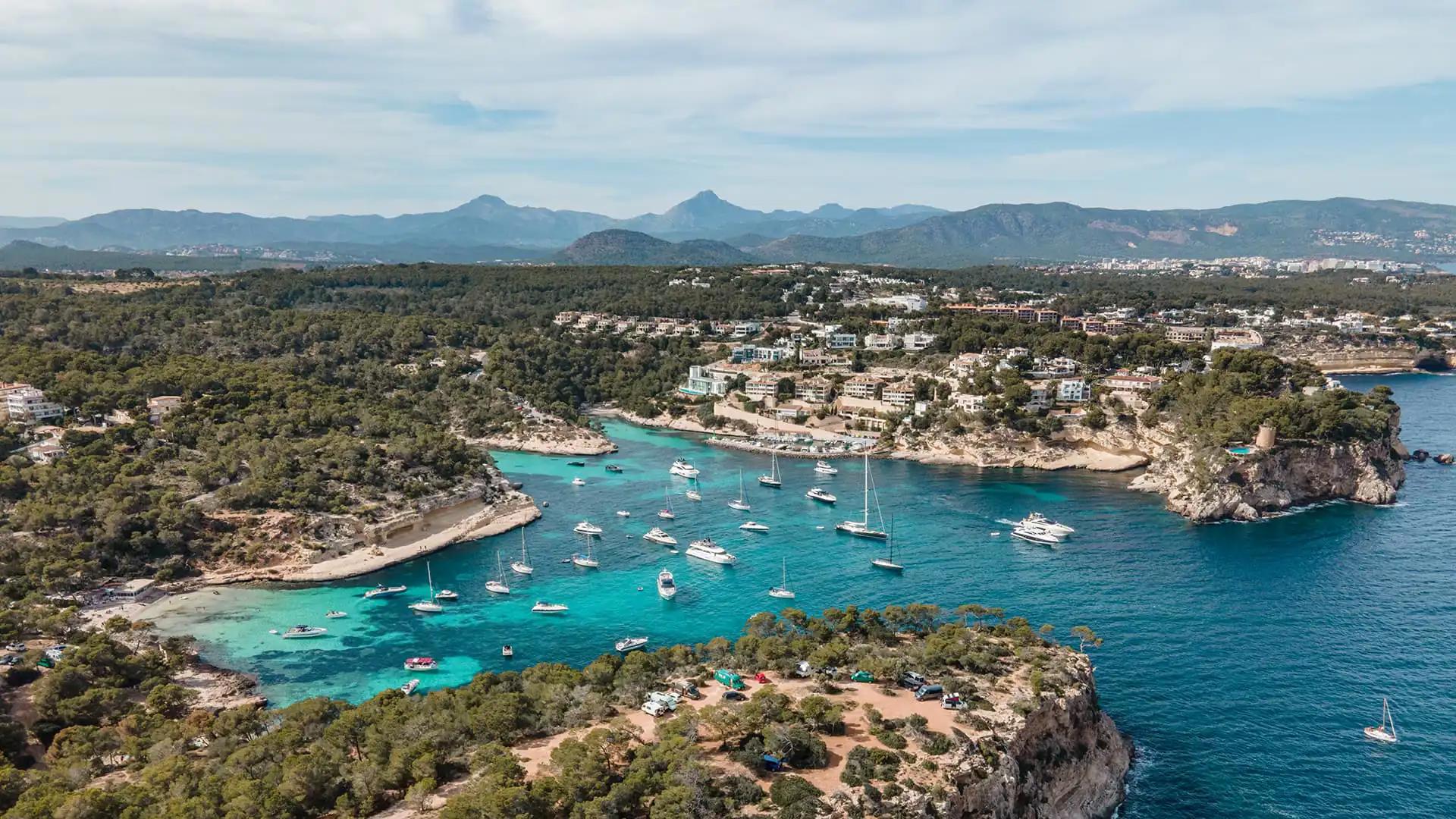
Practical information
🅿️ Parking: Google Maps location at find it here
🗺️ Itinerary: GPX track of our walk at download here
Day 2 • Roadtrip on the Ma-10 from Andratx to Valldemossa
From Palmanova, we head towards Andratx, where the start of a famous road begins: the Ma-10. A winding road between pine trees and peaks, it borders cliffs, crosses charming small villages, and offers ever more beautiful viewpoints.
Ricardo Roca Lookout
The Ricardo Roca Lookout is our first stop of the day, the view is incredible! On one side the sea and its turquoise coves, on the other a winding road buried in the spring Majorcan vegetation. We will unfortunately be chased away by a hundred Vespas that were participating in an organized tour.
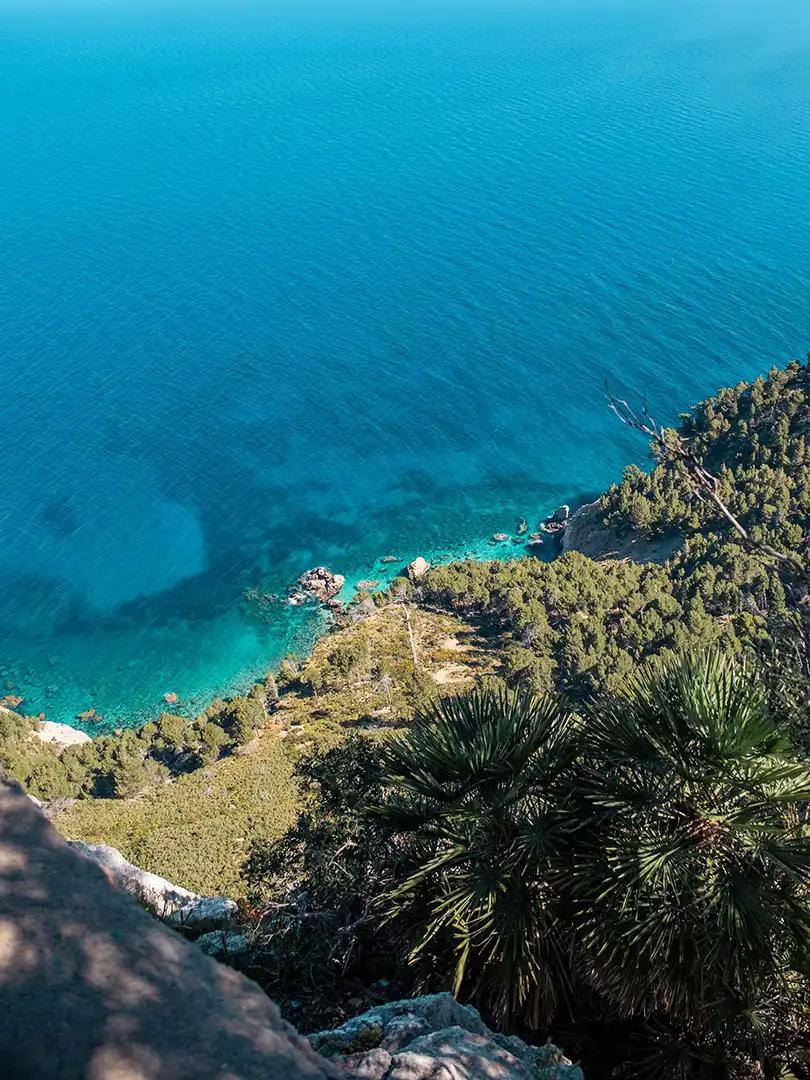
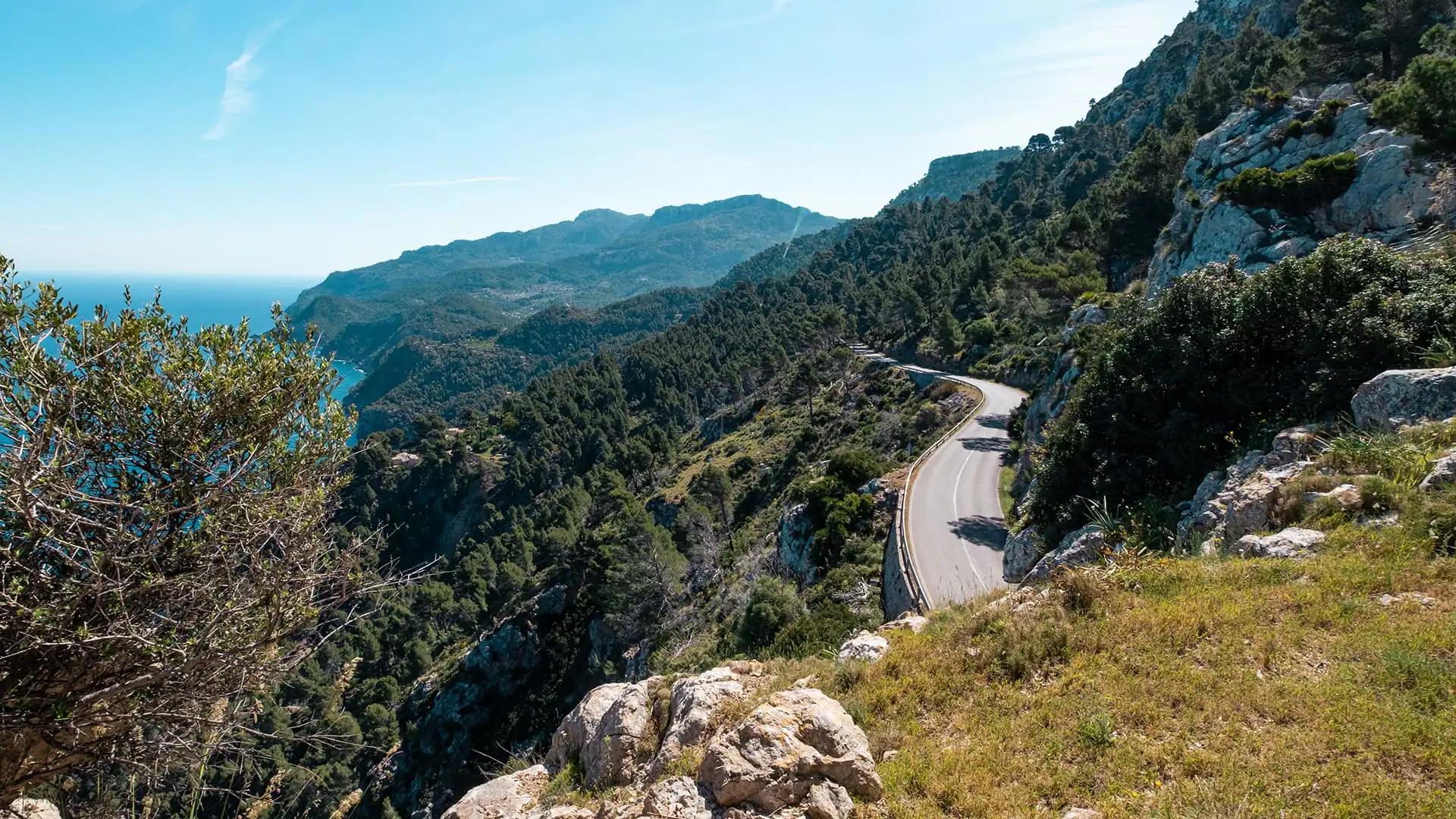
Visiting Estellencs and Banyalbufar
We would have loved to stop at Estellencs and Banyalbufar, small villages with typical charm. Unfortunately, all the parking lots were full and parking on the roadside was really difficult, so we skipped it this time. If you have the opportunity to visit these small Majorcan villages, they seem very beautiful.
Torre del Verger and the Port of sa Pedra de d’Ase
Unfortunately, access to the Torre del Verger viewpoint was closed due to work. We then decided to go down to the small port of Sa Pedra. Once down, we took a spot amongst the small fishing boats facing the sea to enjoy our picnic. The water was a bit cool for us (even though we dipped our feet in), but others less afraid didn't hesitate to jump in for a quick snorkeling session. Be warned, the path to get there is very steep, your legs will work hard ;-)
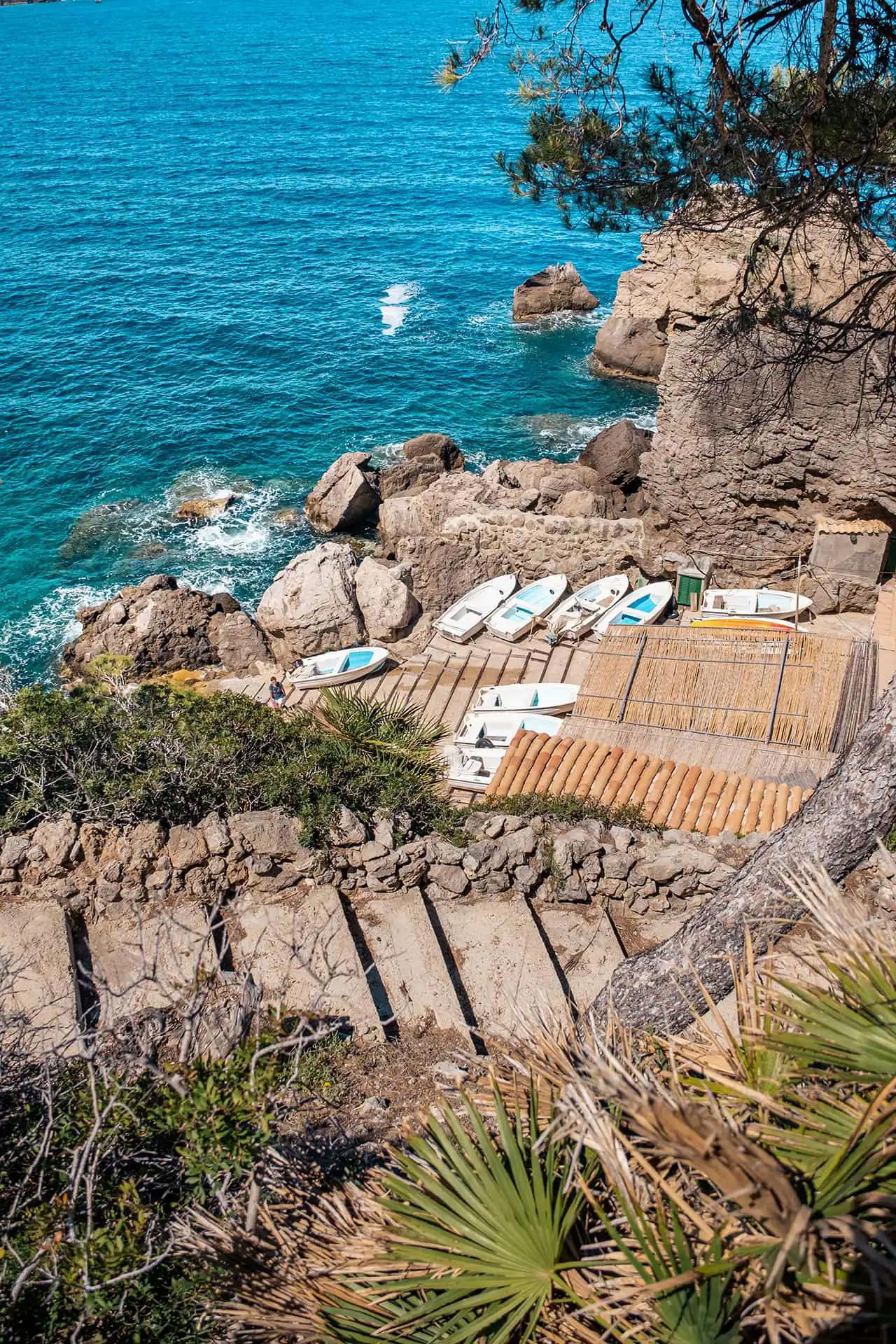
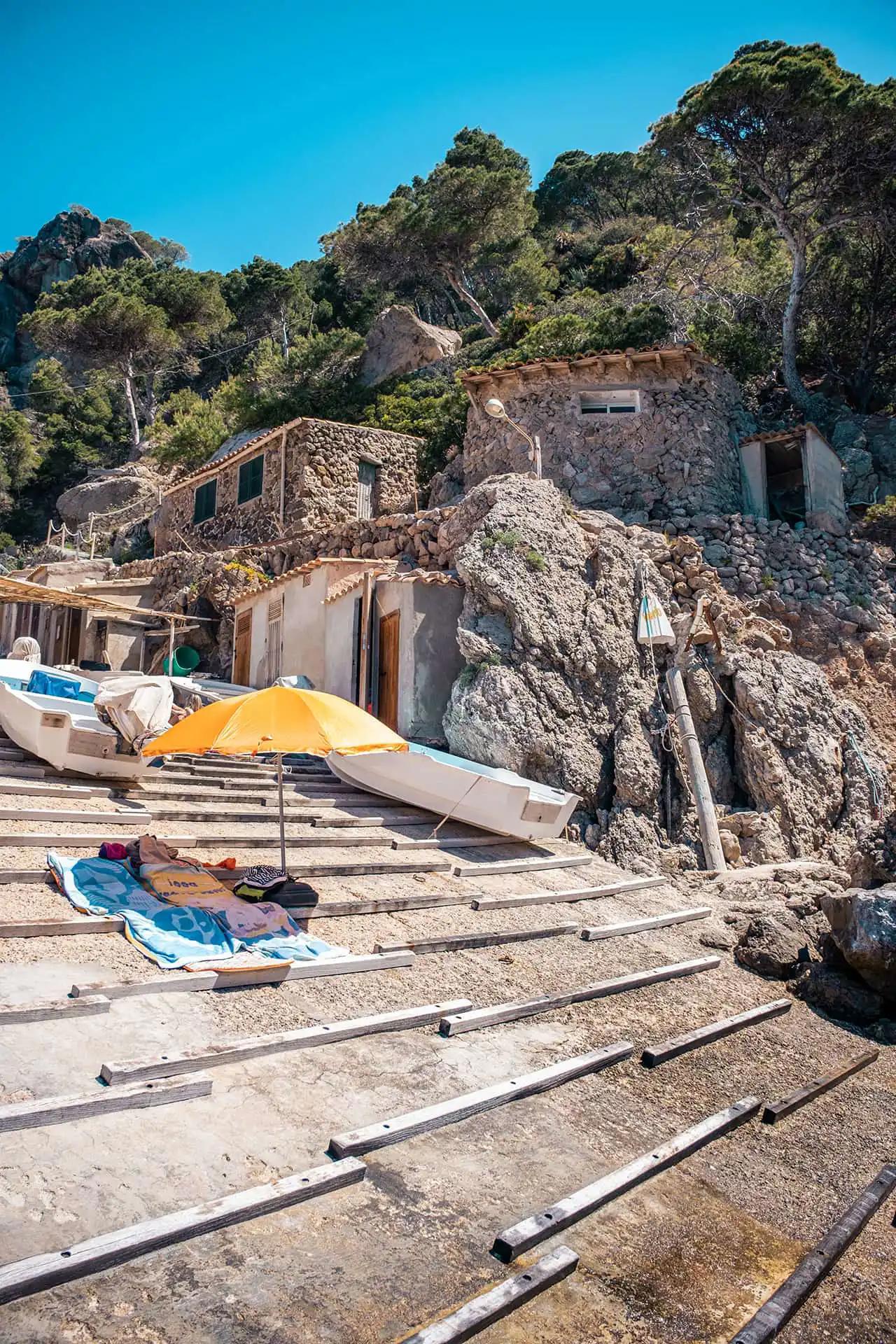
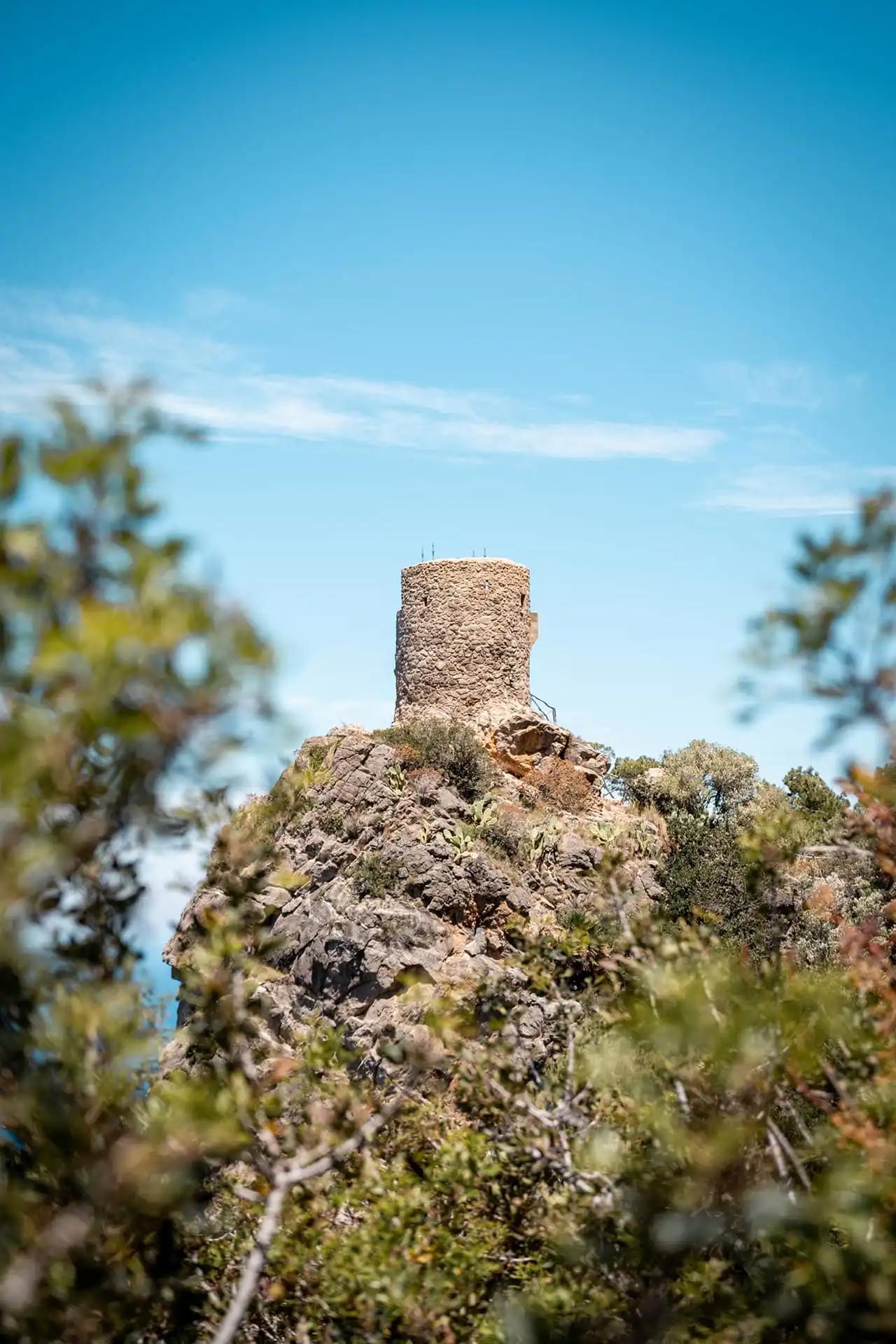
Practical information
🅿️ Parking: Google Maps location at find it here
🗺️ Itinerary: GPX track to reach the port of Sa Pedra at download here
Visit Valldemossa
Valldemossa is one of the must-see villages during your trip to Mallorca and is only 20 km from Palma. It owes its fame to George Sand and Frédéric Chopin who stayed there during the winter of 1839. Get lost in its pedestrian streets, with the typical stone houses of the island to discover the soul of this small village in the heart of the Sierra Tramuntana. We also recommend you to stroll through the Rei Joan Carles gardens which are located just behind the Cartuja church. You can find a statue/portrait of Chopin amidst the rose bushes.
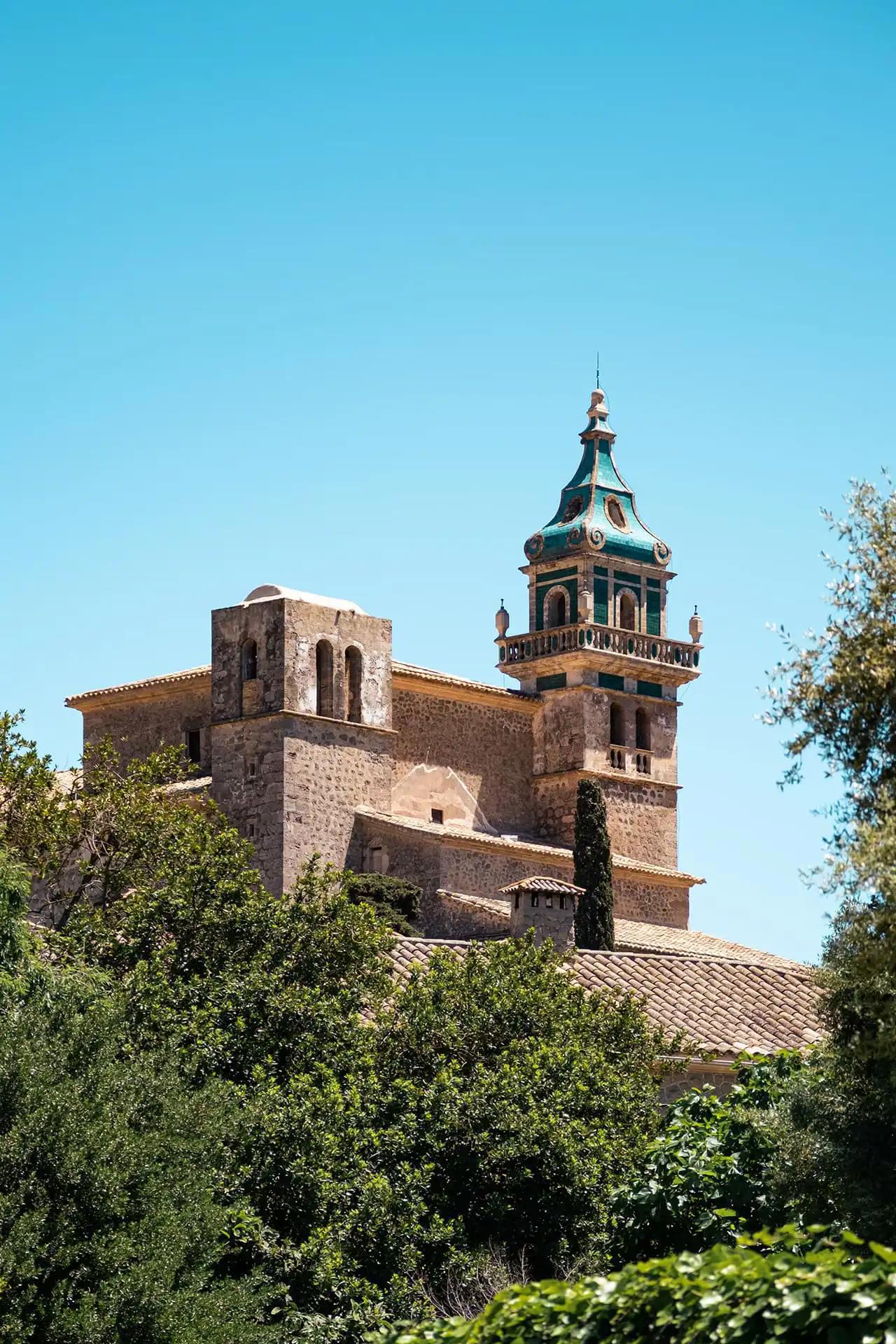
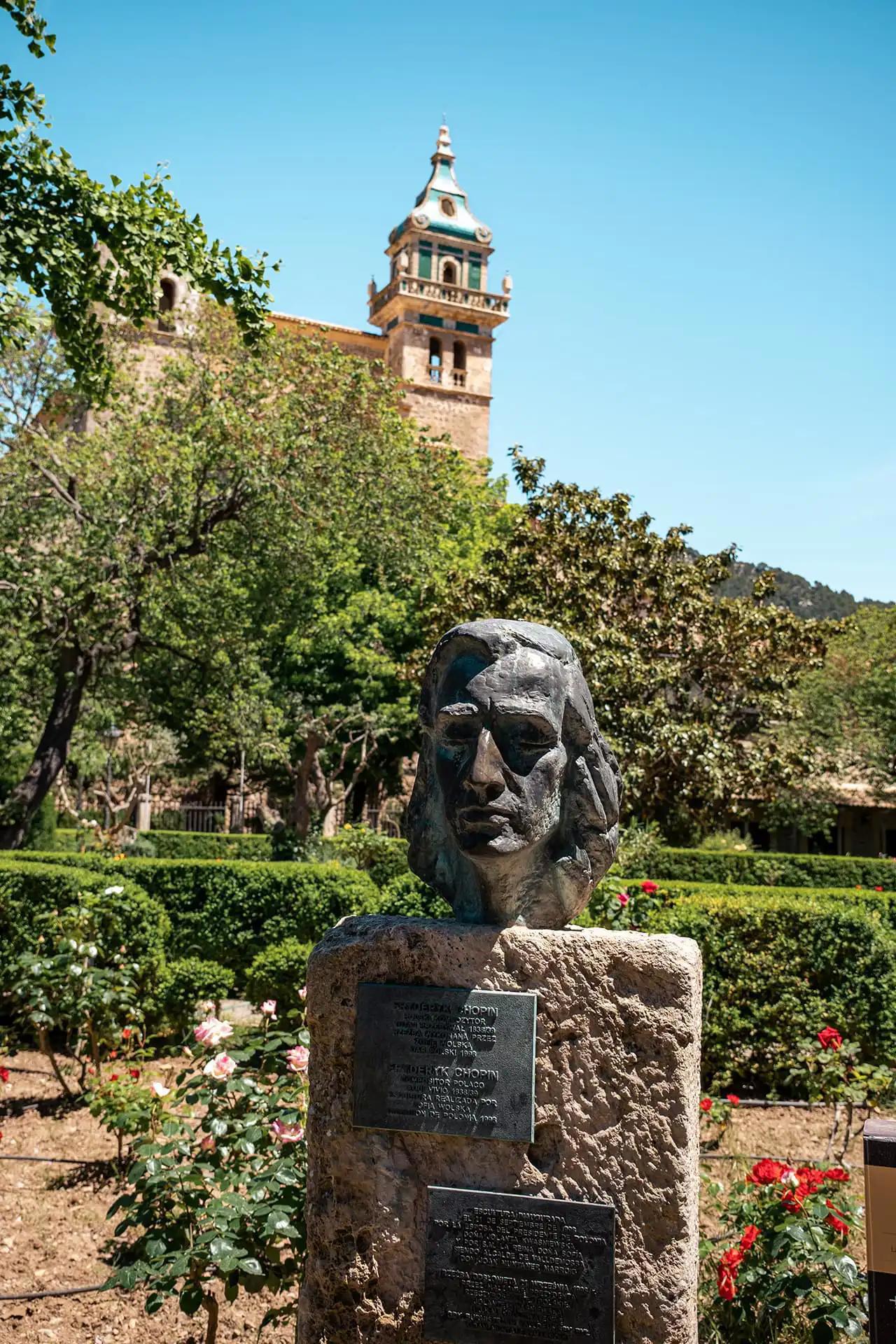
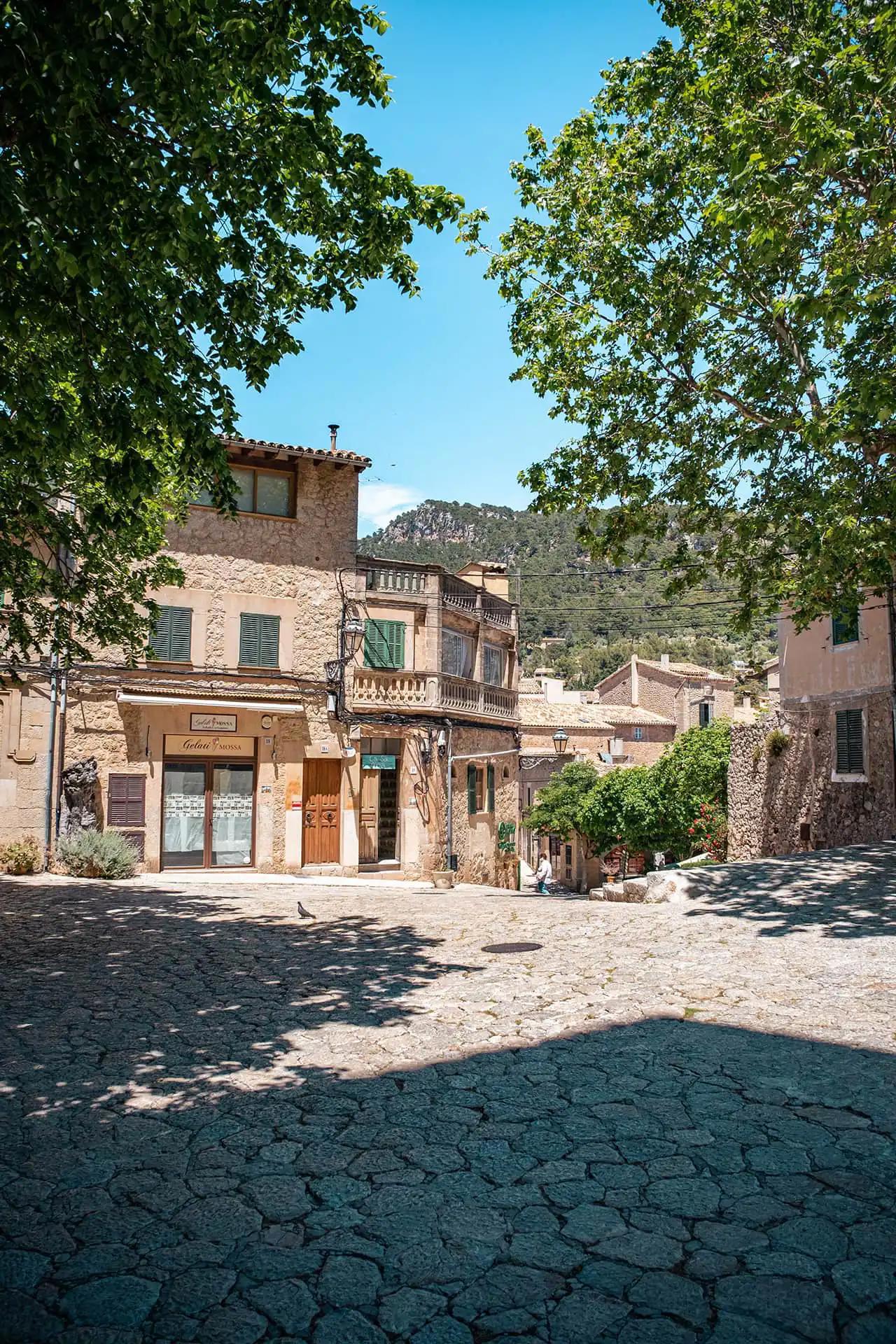
The Miranda des Lledoners offers a beautiful view of part of the village and the Sant Bartomeu church.
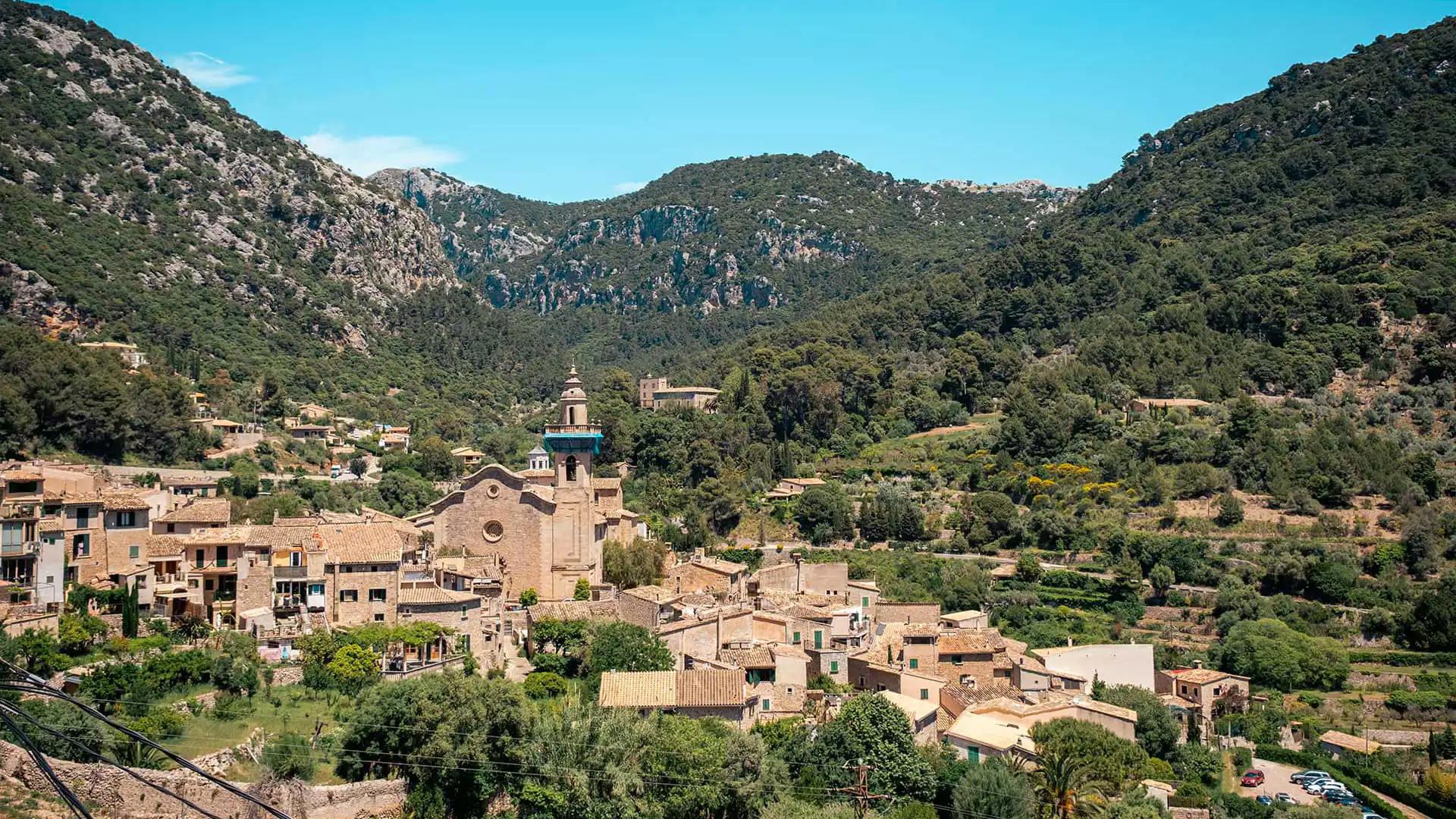
Good addresses in Valldemossa
❤️ Aromas: Big love for this place. We had a drink and a scoop of ice cream. The staff were great and the location has a back garden with a 2-tiered terrace. They sometimes host small live music concerts, it must be magical.
Day 3 • Calo del Moro, a paradise cove & Cala s’Almunia
Calo del Moro, a must-see if you're visiting Majorca. Located in the southeast of Majorca, this white sand cove and its turquoise water make it a little paradise on earth. A 5-minute walk away is its little sister: Cala s'Almunia, carved into the rock.
For more information, visit our top 5 favorite beaches in Majorca.
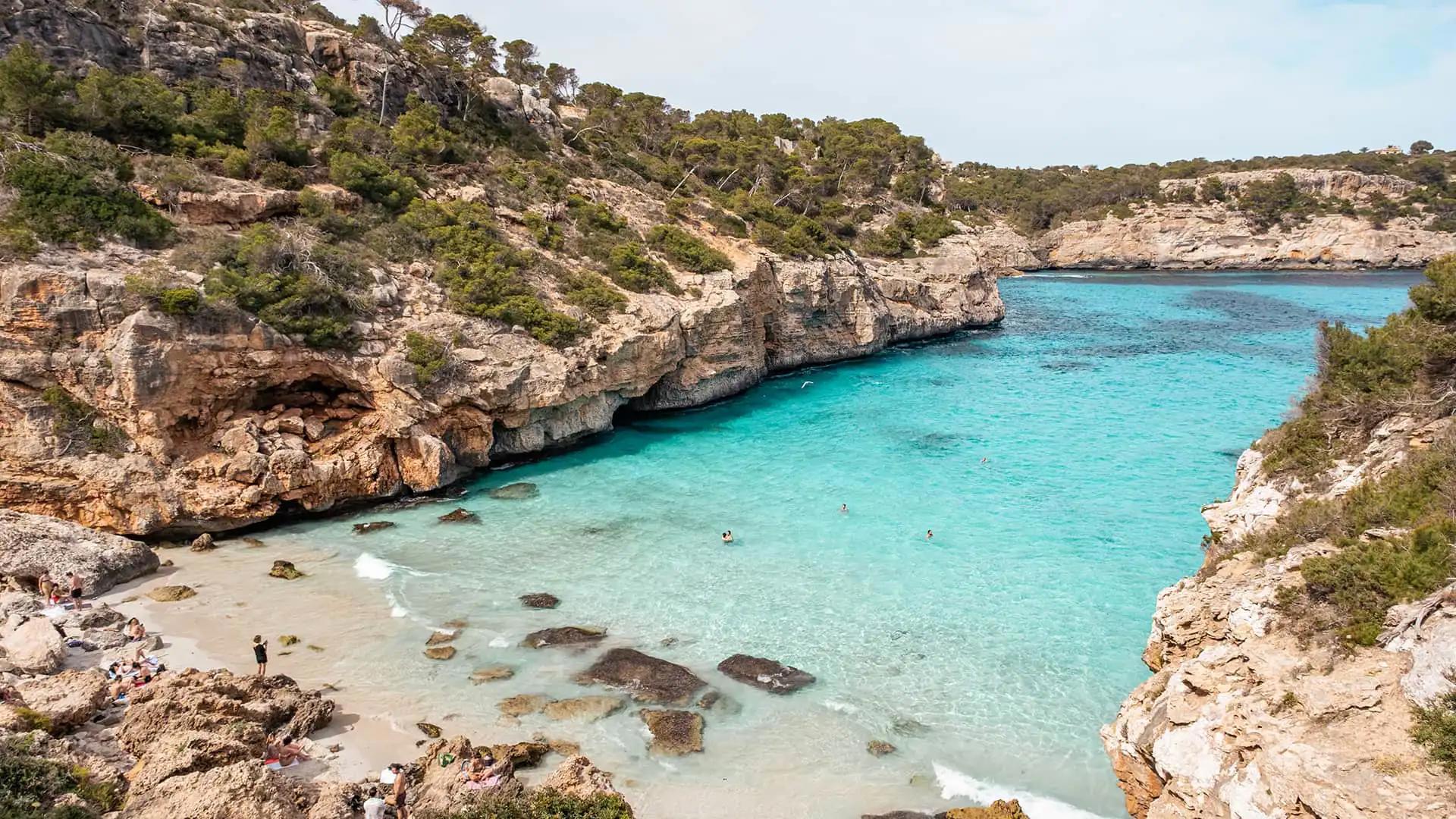
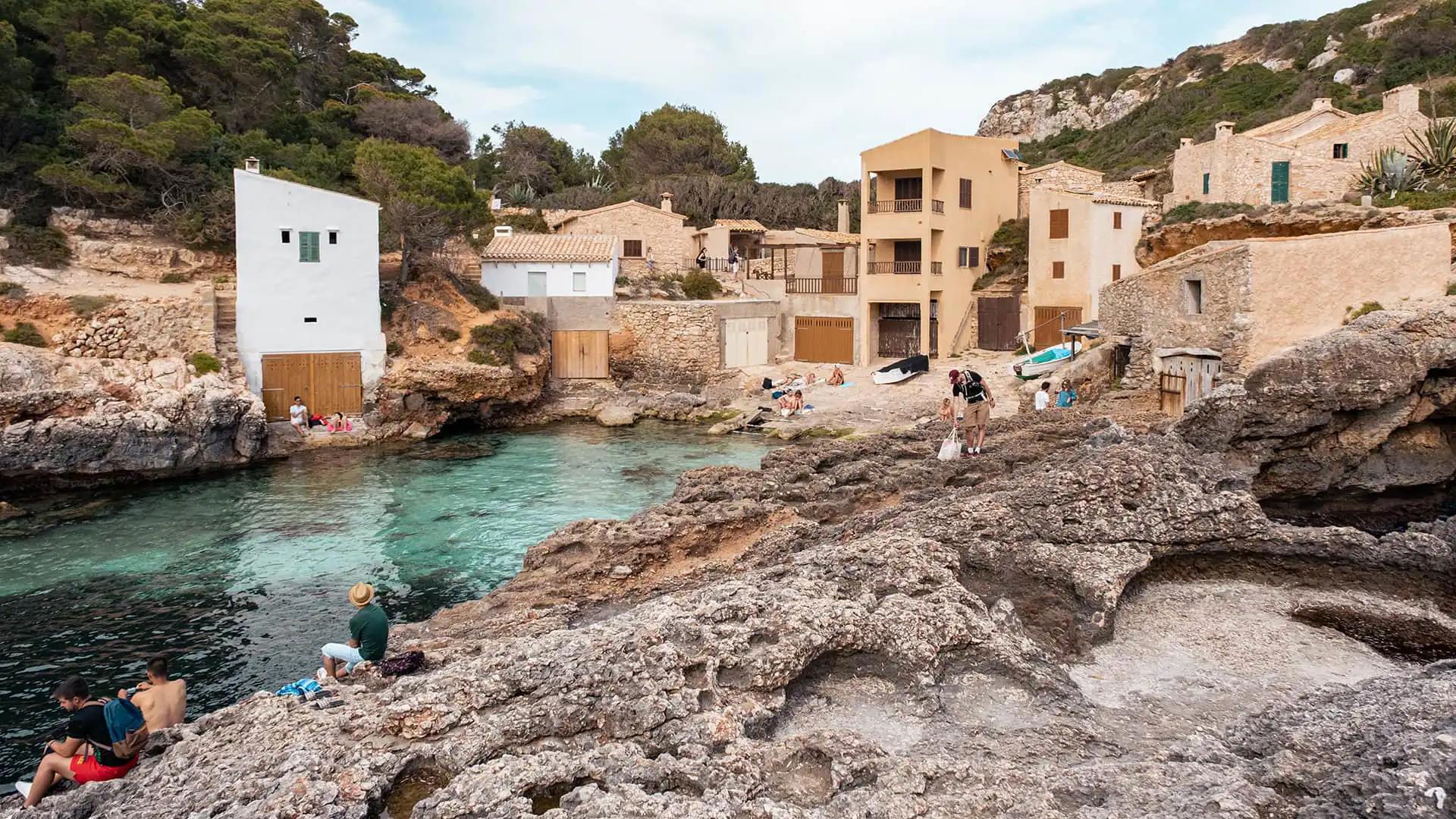
Day 4 • Mondrago Nature Park & Express Trip to Palma
Mondrago Nature Park and its beaches
In the municipality of Santanyi, in southeastern Majorca, you'll find the Mondrago Natural Park, which covers almost 800 hectares. It's been a protected area since 1992 and aims to preserve the fauna and flora. Besides its 3 beaches, Mondrago also has a wetland area (the En Alis Spring), a refuge for many amphibians. If you park near the information point, you just need to push the small gate to access the path leading down to Cala Mondrago. This path passes through this famous wetland area and is much nicer than going down the asphalt road.
It's possible to discover Mondrago thanks to its 5 hiking trails ranging from 25 to 40 minutes. A great idea to explore this nature reserve a bit more and enjoy its viewpoints over the coves with crystal-clear water. If you look carefully, you might spot various bird species and even turtles for the luckiest ones.
We give you more information about the different beaches of the Mondrago Natural Park in our article about our 5 favorite beaches in Majorca.
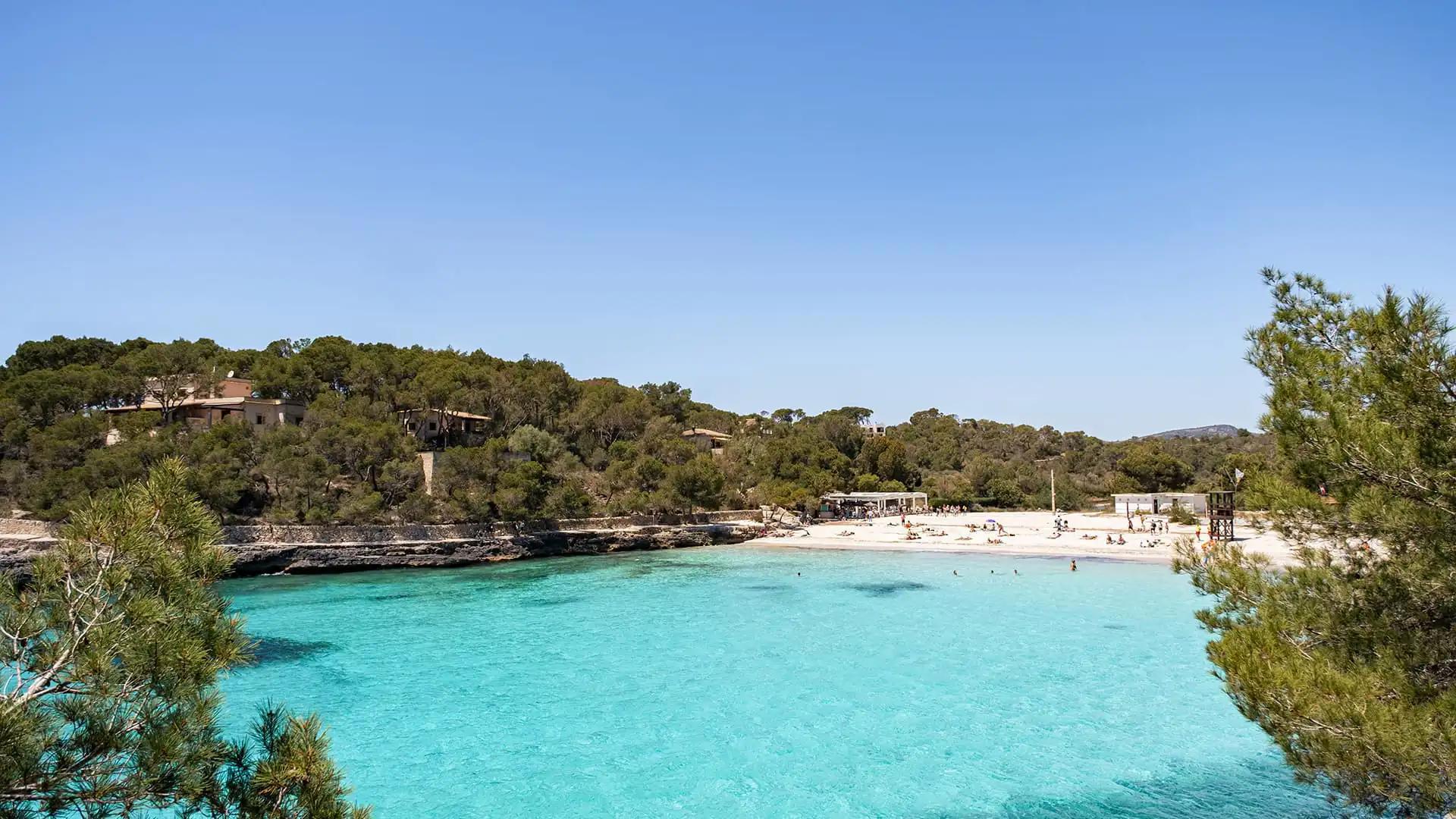
Visit Palma de Mallorca
Palma de Mallorca is the main city of the island of Mallorca and the capital of the Balearic Islands. One comes to see its imposing cathedral, and its Gothic style, which stands facing the sea. Having passed by on a whim and poorly informed, we did not have a love affair with Palma and its city center. To be done again next time with a list of points of interest and things to see.
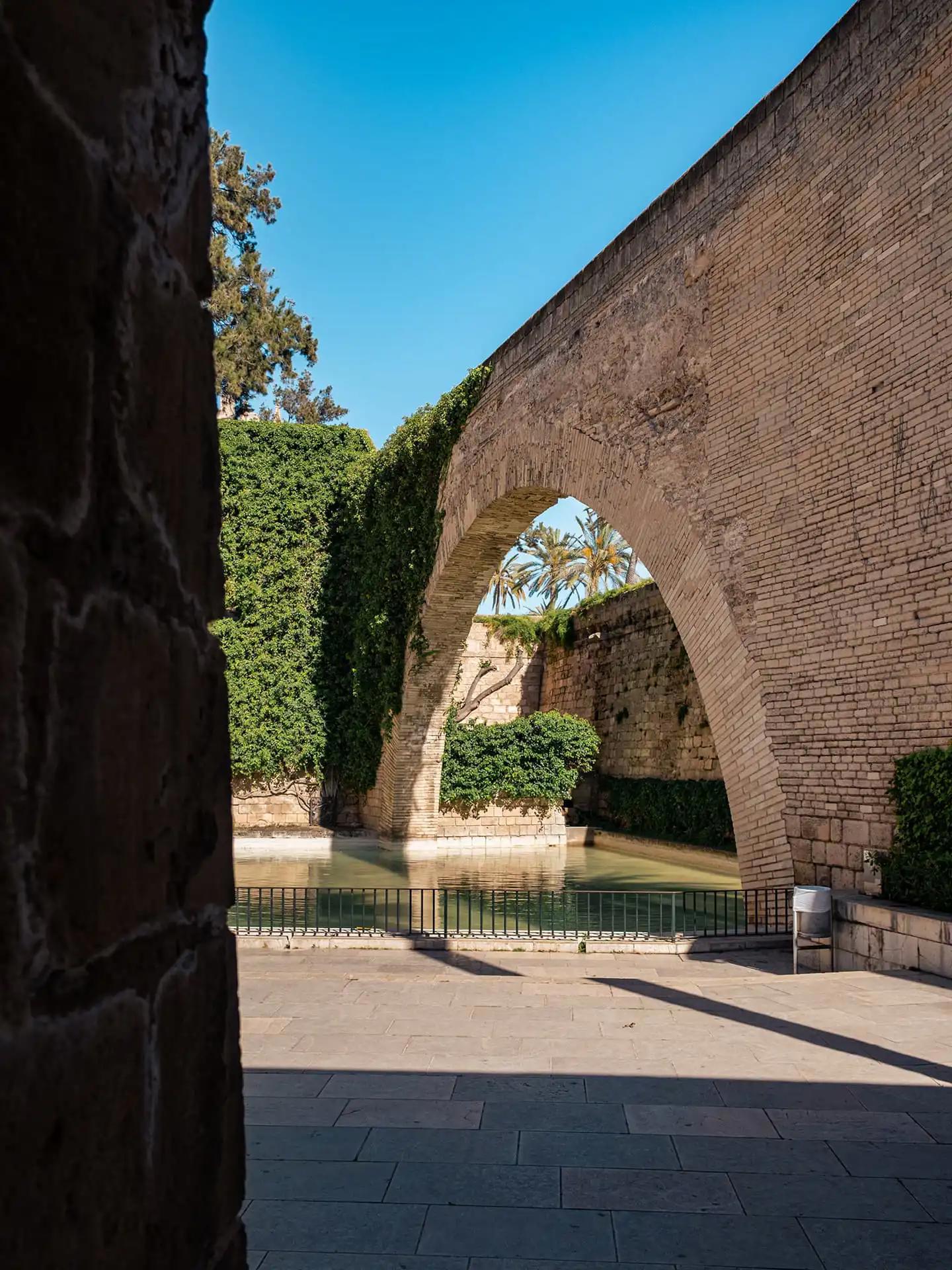
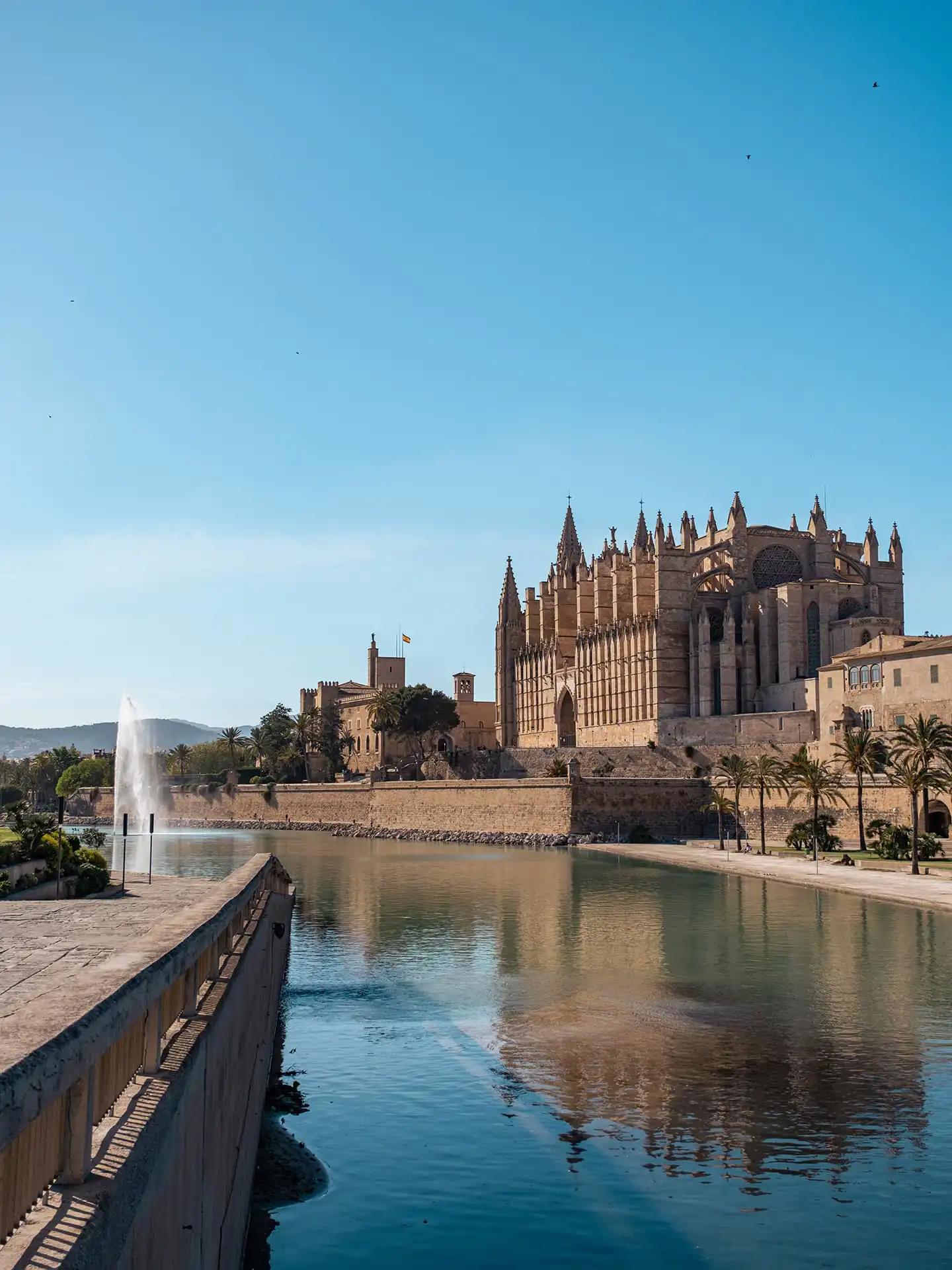
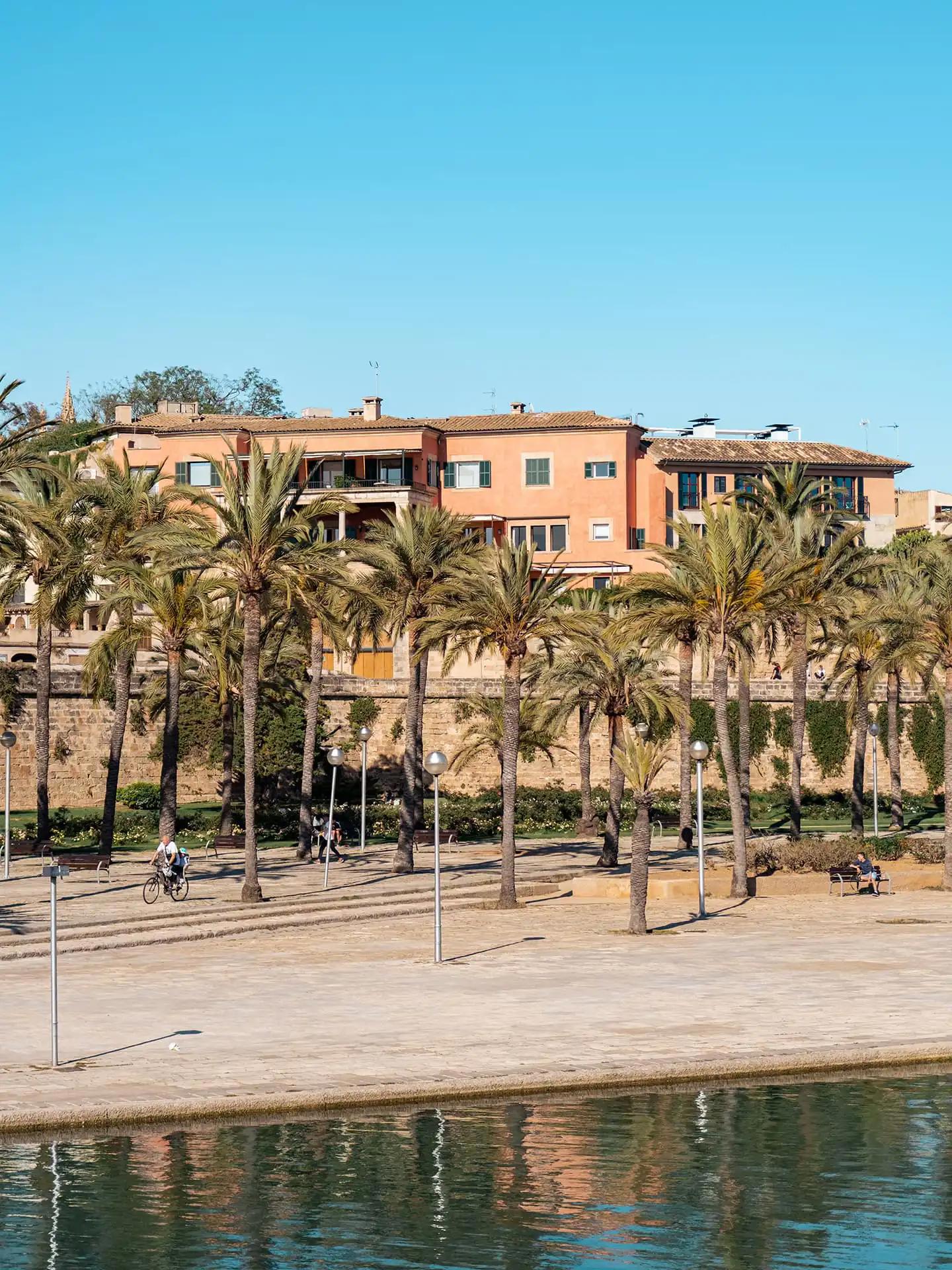
Good addresses in Palma de Mallorca
🍺 The Guinness House : We stopped here for a drink with a view of the water and the cathedral. €4 for a coke and not always friendly waiters… Thankfully the cathedral remained unimpressed 😉
Day 5 • Hiking in the Serra de Tramuntana
First day of gray skies since our arrival. We decide to take advantage of it to explore the land a little more and take a short hike to the Puig de na Bauçana. We leave by car, heading towards the heart of the Serra de Tramuntana, the main mountain range of Mallorca, classified as a UNESCO World Heritage site.
After arriving at the small village of Puigpunyent, we take the Ma-1032 towards Galilea. After about ten minutes driving on the small roads, we see the start of the hike: a green gate with a roadside area that can accommodate 3 to 4 cars.


We are therefore off on the 2.5 kilometers of hiking before reaching the summit of the Puig de na Bauçana at 614 meters above sea level. The first two-thirds of the hike are easy and offer beautiful views of the village of Galilea. The last third climbs quite steeply, between more or less developed stairs and a path that is no longer defined at all. Fortunately, the summit is not far away and you can easily spot me 😉

Once arrived at the very top, at the Puig de na Bauçana, the view is incredible! From atop our rocks, we have a 360° view around and we can repeatedly see the sea in the distance. We take advantage of this magnificent panorama to have our picnic and observe the clouds dancing above our heads. The return to the car is made by the same path, this time downhill.
Practical information
🗺️ Itinerary: Downloadable GPX track of our walk here
🥾 Distance: 6.3 km
🅿️ Parking: Google Maps location available here
Day 6 • Visit to Cap Formentor
Another must-see place in Mallorca: Cap Formentor. Located at the northwestern tip of Mallorca, it marks the end of the Serra de Tramuntana — the main mountainous massif of Mallorca, classified as a UNESCO World Heritage site since 2011 to preserve its natural environment.
Es Colomer Lookout
Our first stop, the Es Colomer viewpoint. A small parking area is provided by the roadside; if it's full, don't worry: people don't stay very long and spaces become available quickly. From there, we take the paved path with its few stone steps. More than 200 meters above sea level, we are amazed by this wild and preserved landscape. You can see the Pollença Bay and the Formentor Peninsula.
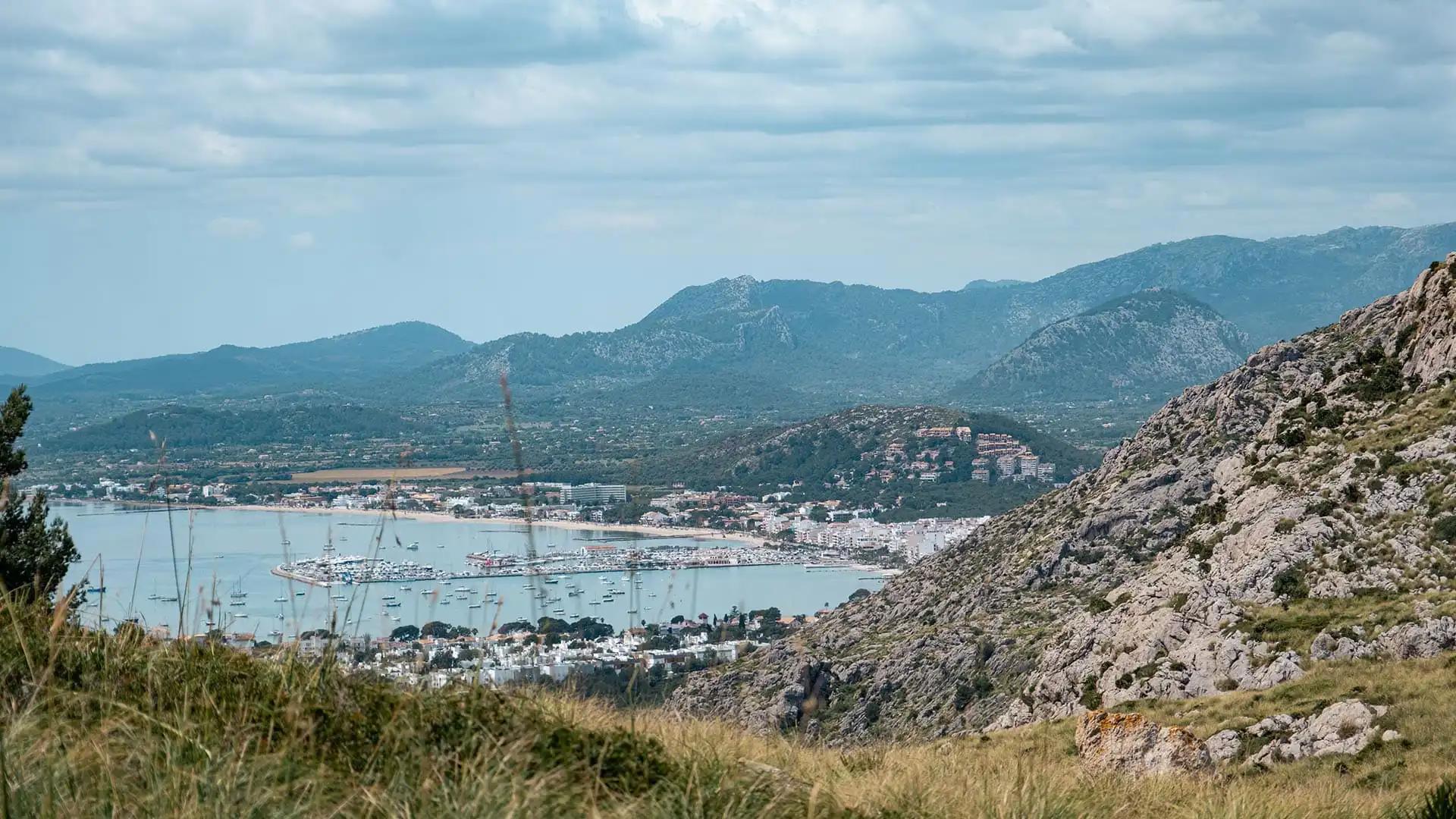
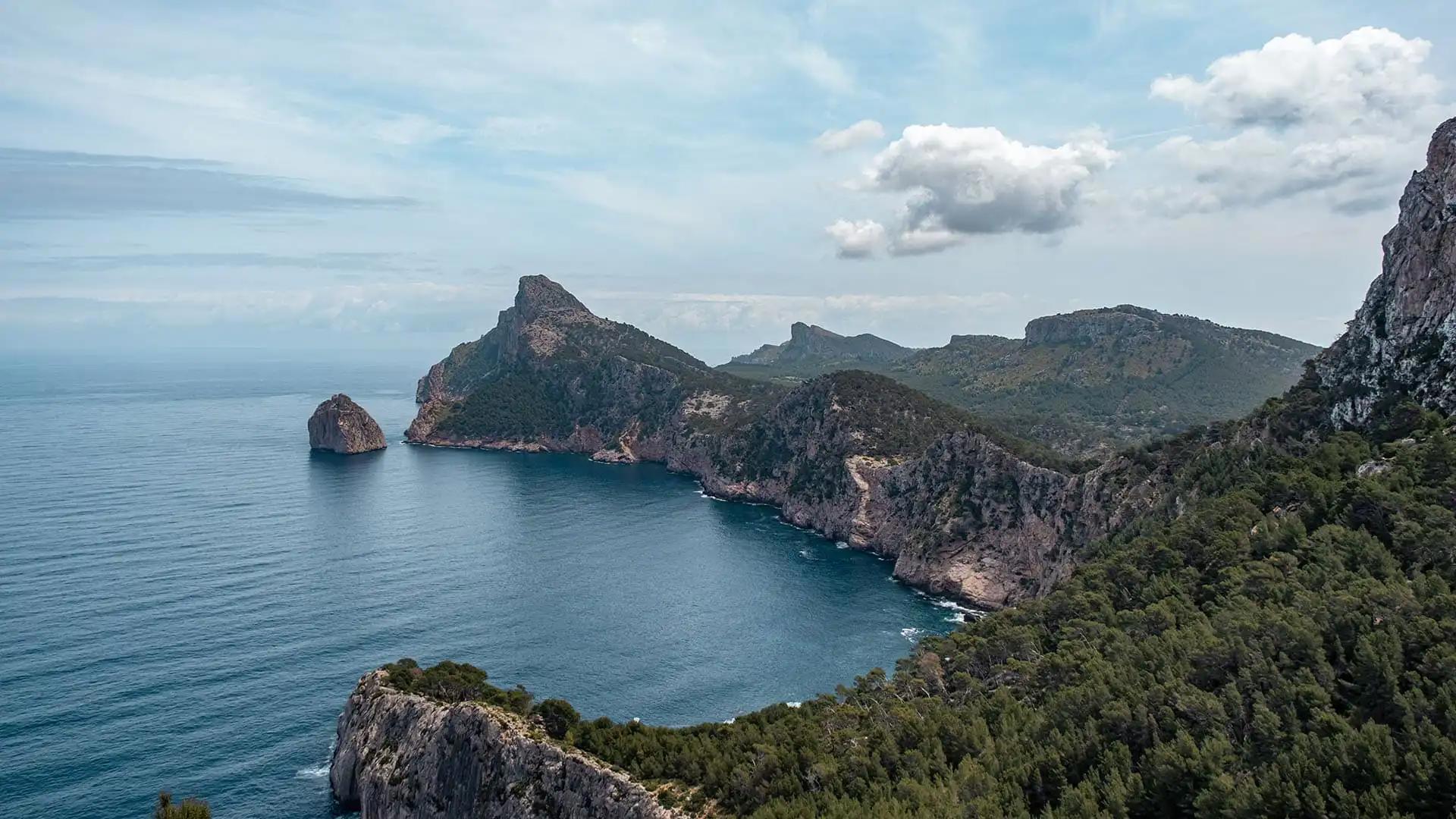
Watchtower of Albercutx
We get back in the car and take this winding little road that we can see from Es Colomer towards the summit where the Mirador de Talaia d’Albercutx is located. Luckily, we don't encounter any vehicles, as the road isn't very wide. There isn't really any parking here, so we park the car by the roadside, behind other cars already there. We finish the last few meters of the road on foot, enjoying the view and getting to know some goats that are roaming free.
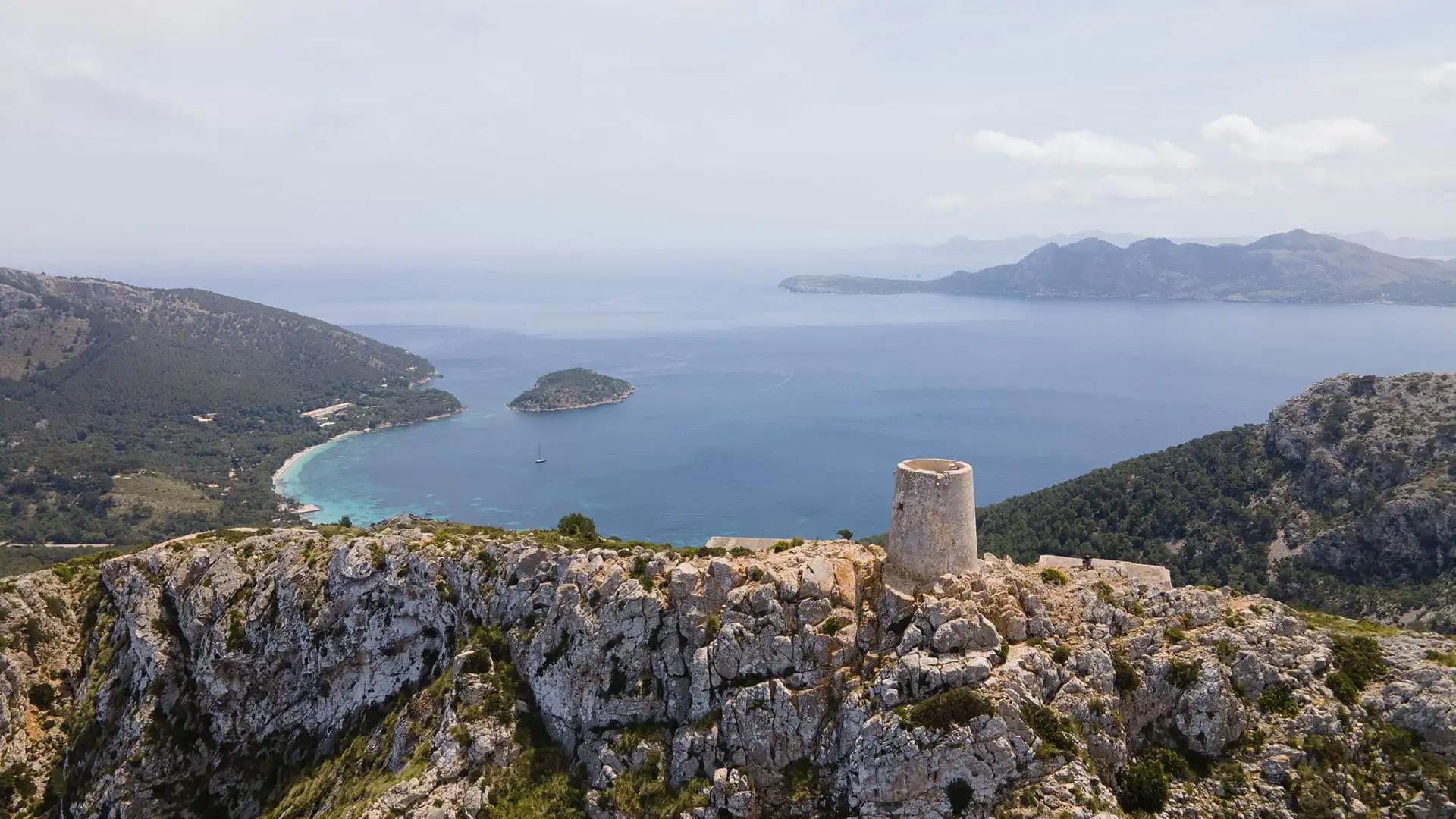
Reaching 380 meters in altitude, the panorama from the Tour d'Albercutx is incredible! We have a 360° view of the surroundings. On one side, there is the Bay of Pollença and Formentor beach with its turquoise water. On the other, we find the Mirador d'Es Colomer and the Formentor peninsula below. Arriving at noon, there are hardly any people, so we take advantage of it to eat our sandwich with the view.
Formentor Lighthouse
We continue our journey to the northwest tip of the island where the Formentor lighthouse is located. We see free-roaming goats along the roadside, cross tunnels and plains, and the landscapes become more breathtaking than the last. At the end of the road, we can see the lighthouse perched atop a cliff, more than 180 meters above sea level. The keeper's house is now a restaurant.
Parking is available at the base of the lighthouse to stop and enjoy the surroundings.
To get a beautiful view of the Formentor lighthouse and the winding road, you need to stop on the opposite slope and gain a little altitude.
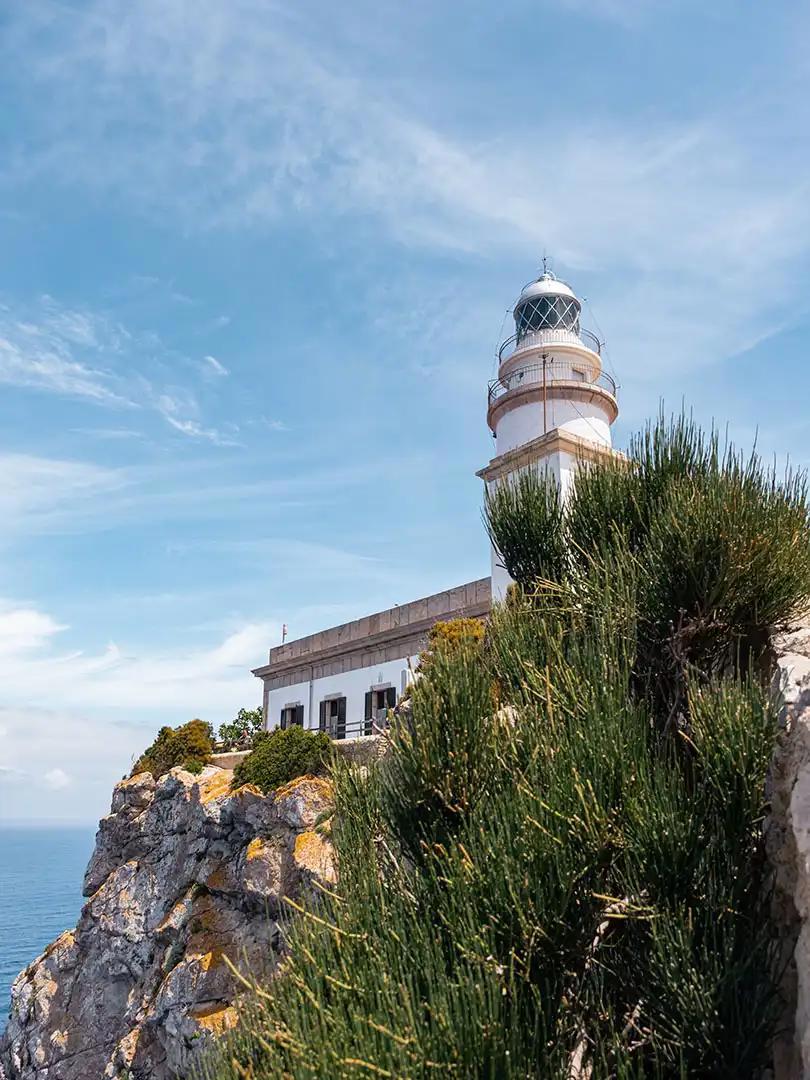
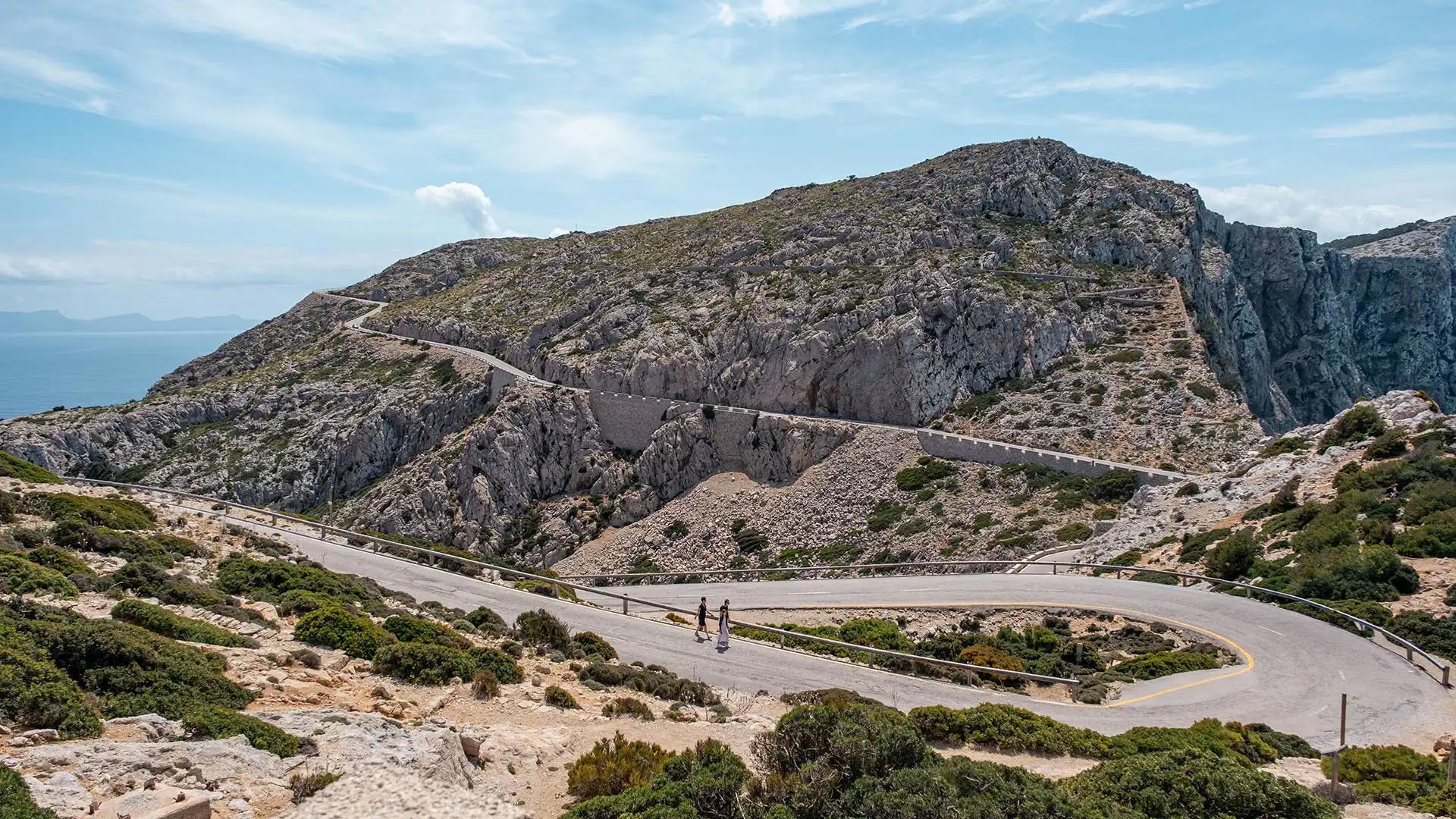
After spending the day on the road, we treat ourselves to a quick dip in the sea at Platja de San Pere, full of tourists. You can find all the information in our article about our 5 favorite beaches in Mallorca.
Practical information
Attention! From June 15th to September 15th, access to the lighthouse from the beach is restricted from 10am to 7pm. Only authorized vehicles, bus passengers, cyclists, and hikers have free access. A shuttle is available from Pollença to the Formentor Lighthouse, stopping at various points of interest.
Day 7 • Sa Dragonera, visit the wild lizard island
Sa Dragonera or the Lizard Island is an island located in the extreme west of Majorca off the coast of Sant Elm.
This island of almost 3km² is located 300 meters from the Majorcan coast, making it easily accessible; initially, we even planned to cross it by kayak from the small port of Sant Elm. Unfortunately, that day the wind picked up, roughening the sea and making the kayak trip too dangerous, so we opted for the shuttle that runs back and forth every hour for 30 minutes for 15€ round trip per person.
Sa Dragonera is a highly regulated nature park, it is only possible to visit it to observe the lush nature that the island boasts and to walk around. The nature park is open all year round from 10am to 3pm and until 5pm between April 1st and September 30th.
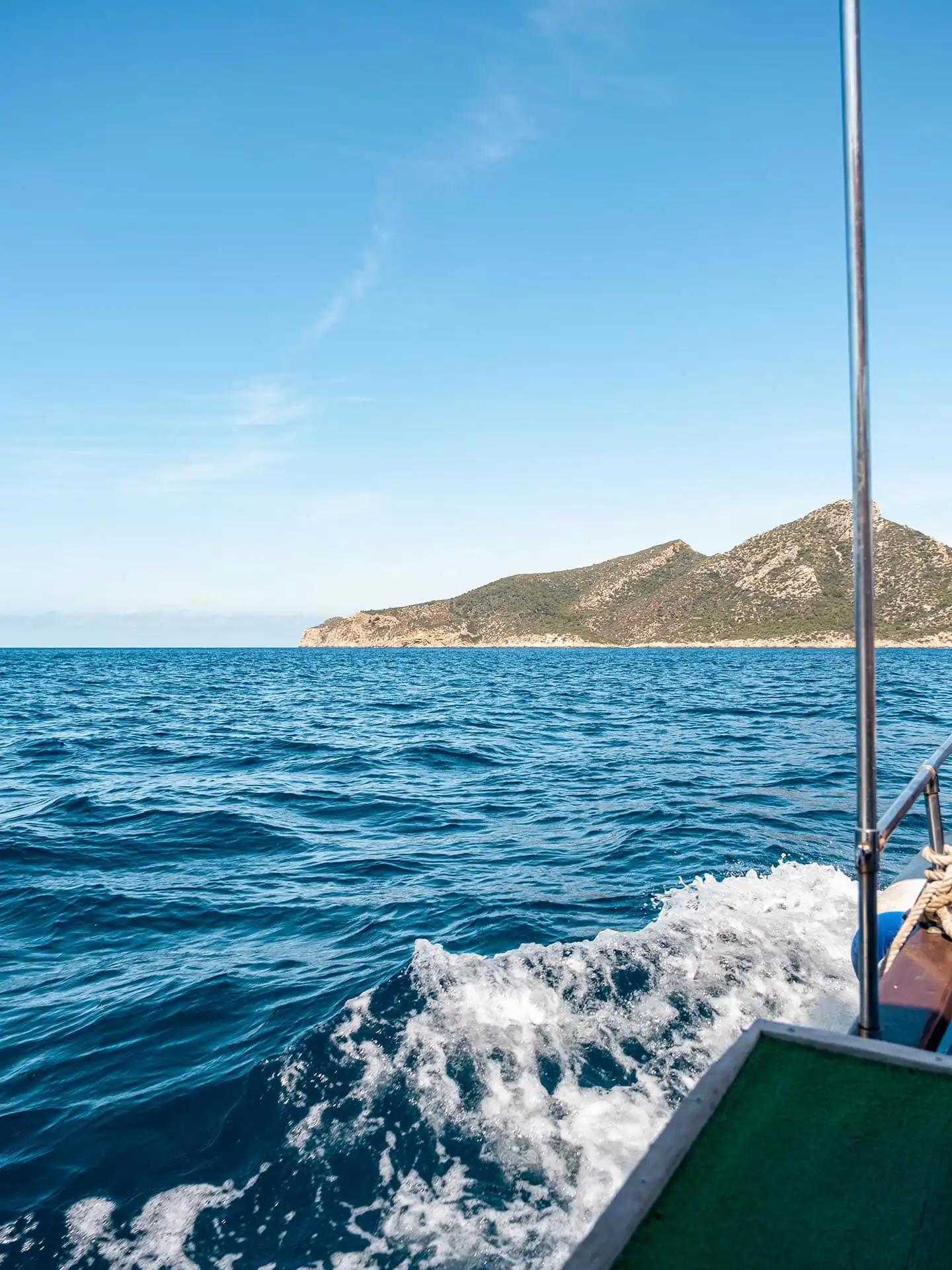
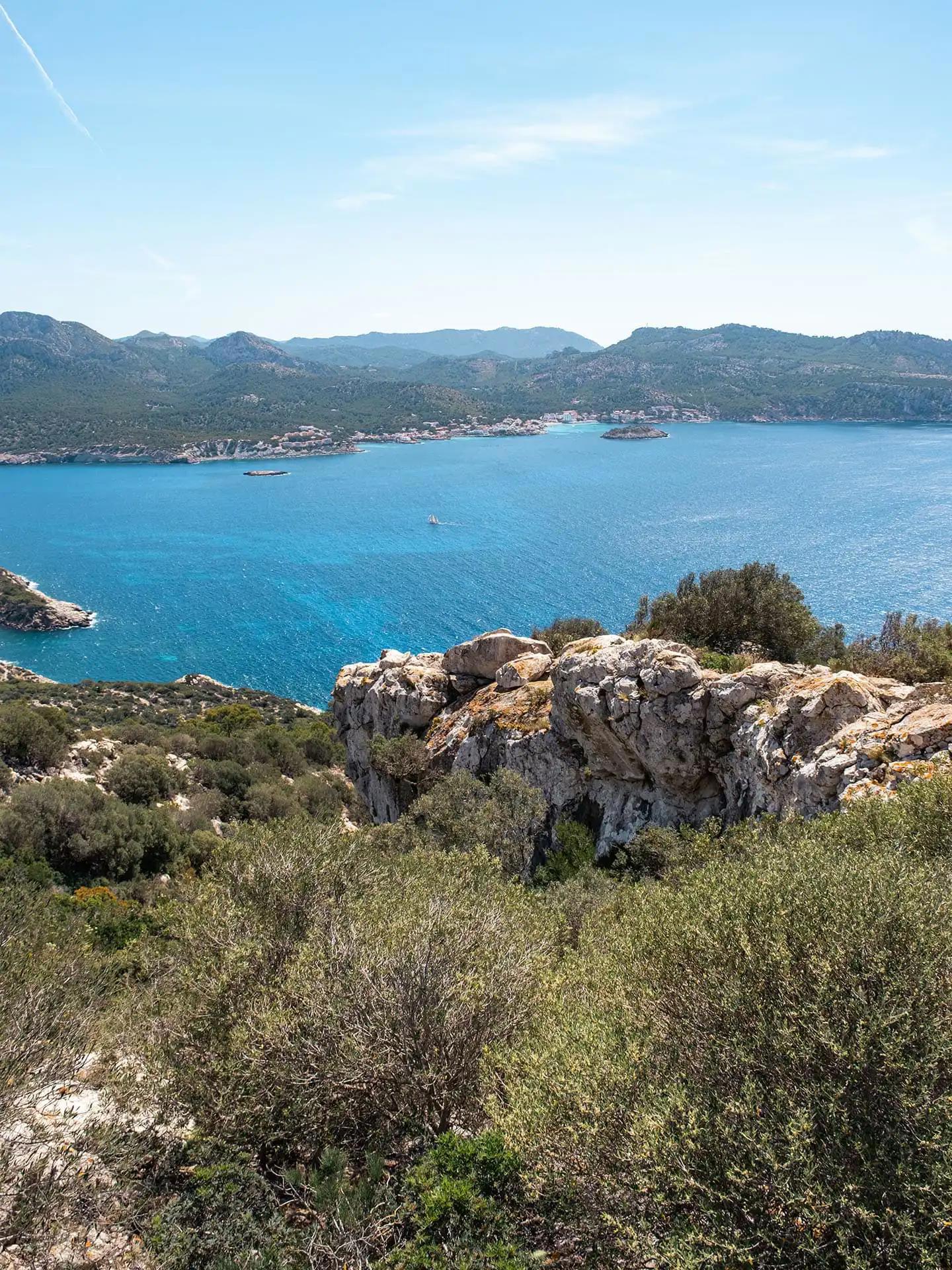
Hikes in Sa Dragonera
Once on the island you will have the choice between 4 hiking trails ranging from 1.2 km to 4.5 km allowing you to explore the island from end to end and even from above! It is this last option that we chose, taking the path leading to the top of the island towards the ruins of the old Na Popia lighthouse. With its 350m of elevation gain, it will take nearly 3 hours to make the round trip while enjoying the views and nature.
An information board with a map is available at the arrival point, as well as numerous signs will indicate the paths to follow to stroll around the island.
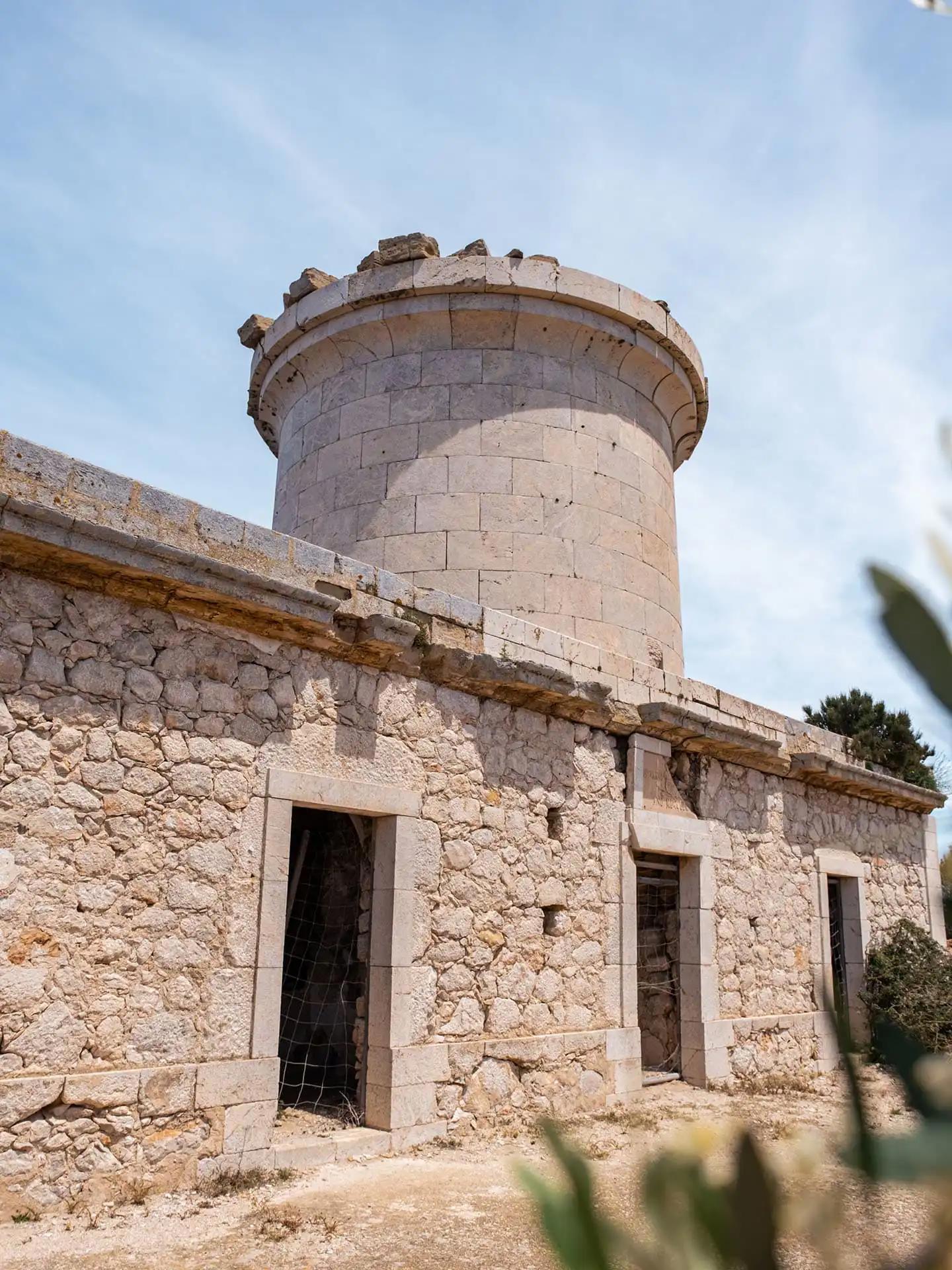
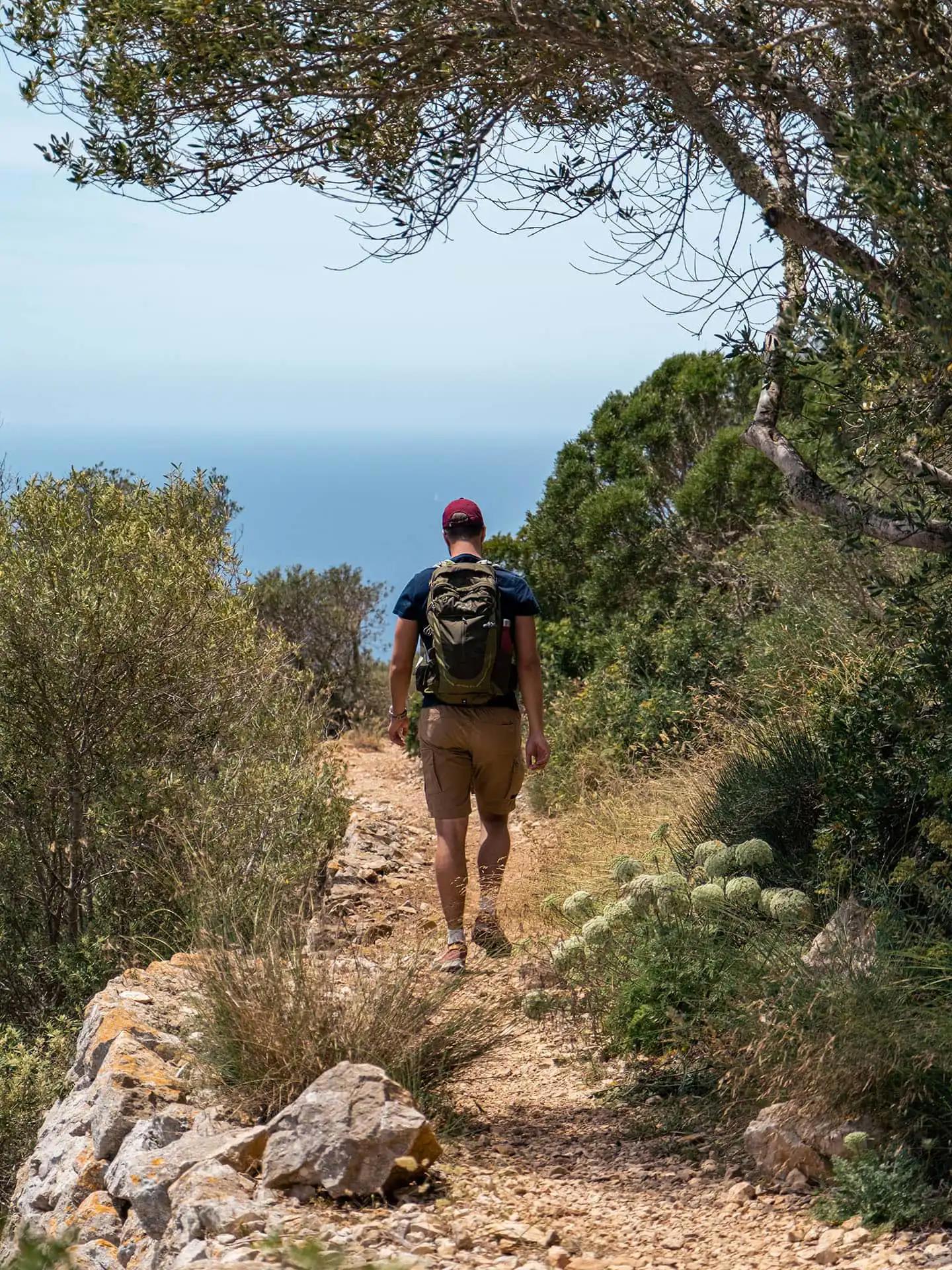
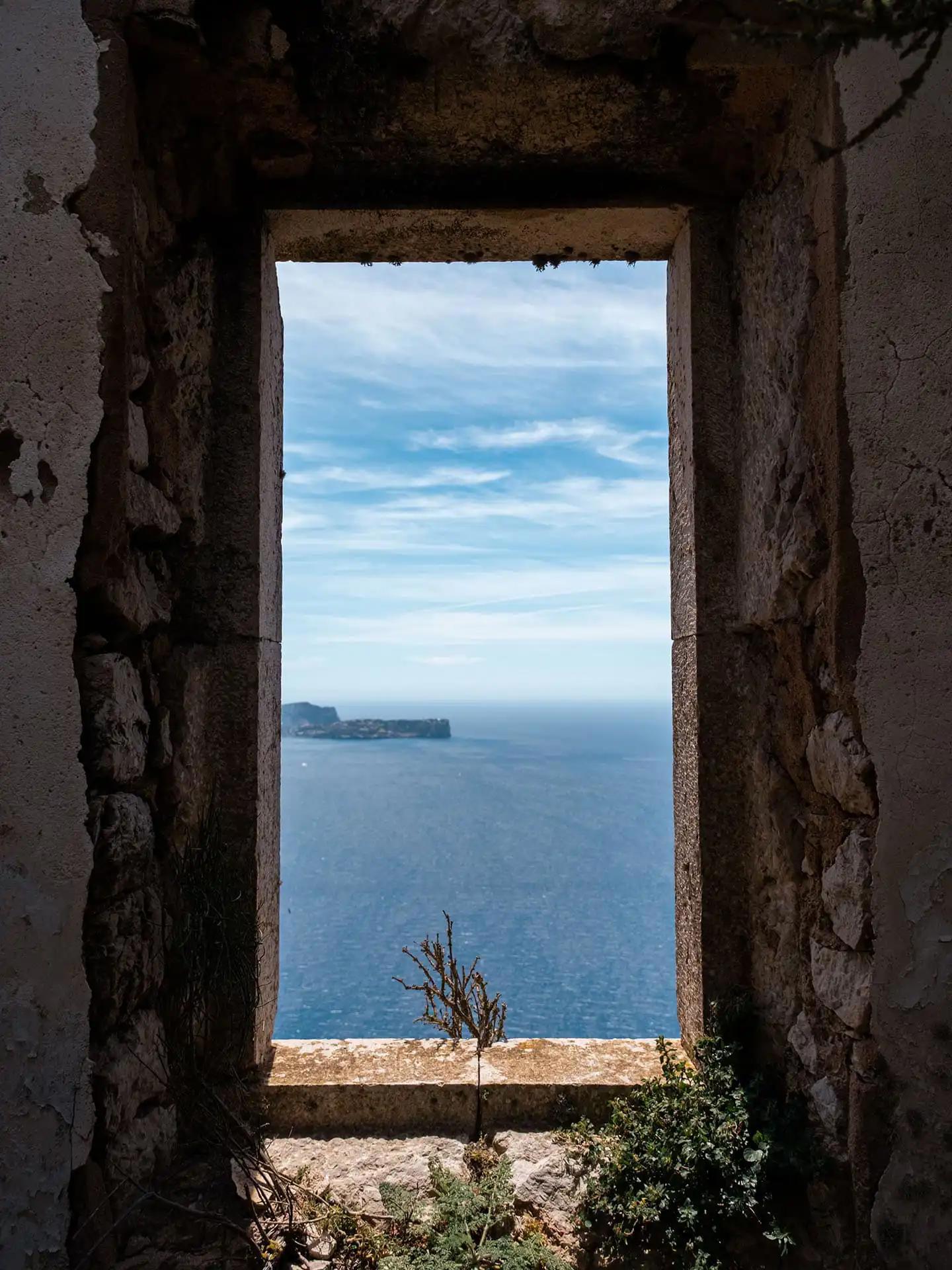
Lizard Island, its fauna and flora
On the paths, you will feel observed and perceive subtle movements in the tall grass and leaves around you before realizing that hundreds of lizards accompany you on the path. And yes, Sa Dragonera is not called the "lizard island" by chance, an endemic lizard species has made its home there and it is really easy to approach and observe them freely.
Sa Dragonera being a **protected natural park**, many species of birds, but also plants have found refuge there. Among the many gull families, you will be able to see two species of falcons: Peregrine and Eleanor. In terms of flora, the island is teeming with olive trees, pines, aromatic plants and has several endemic species to the island.
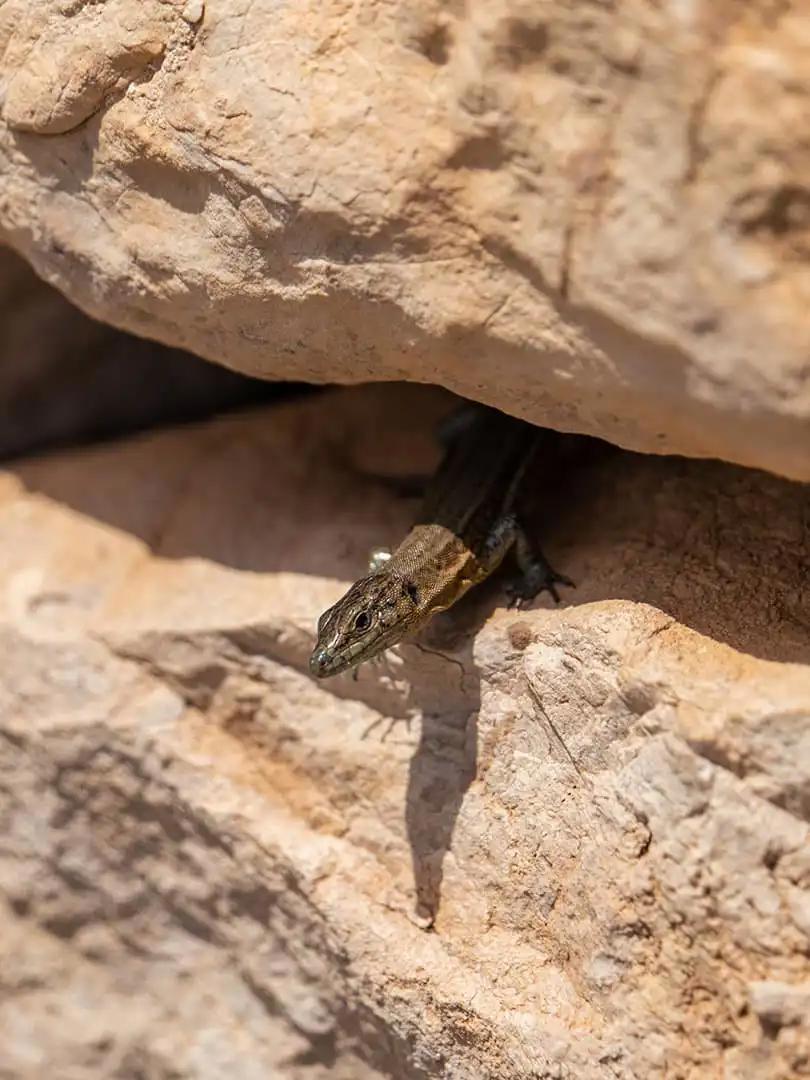
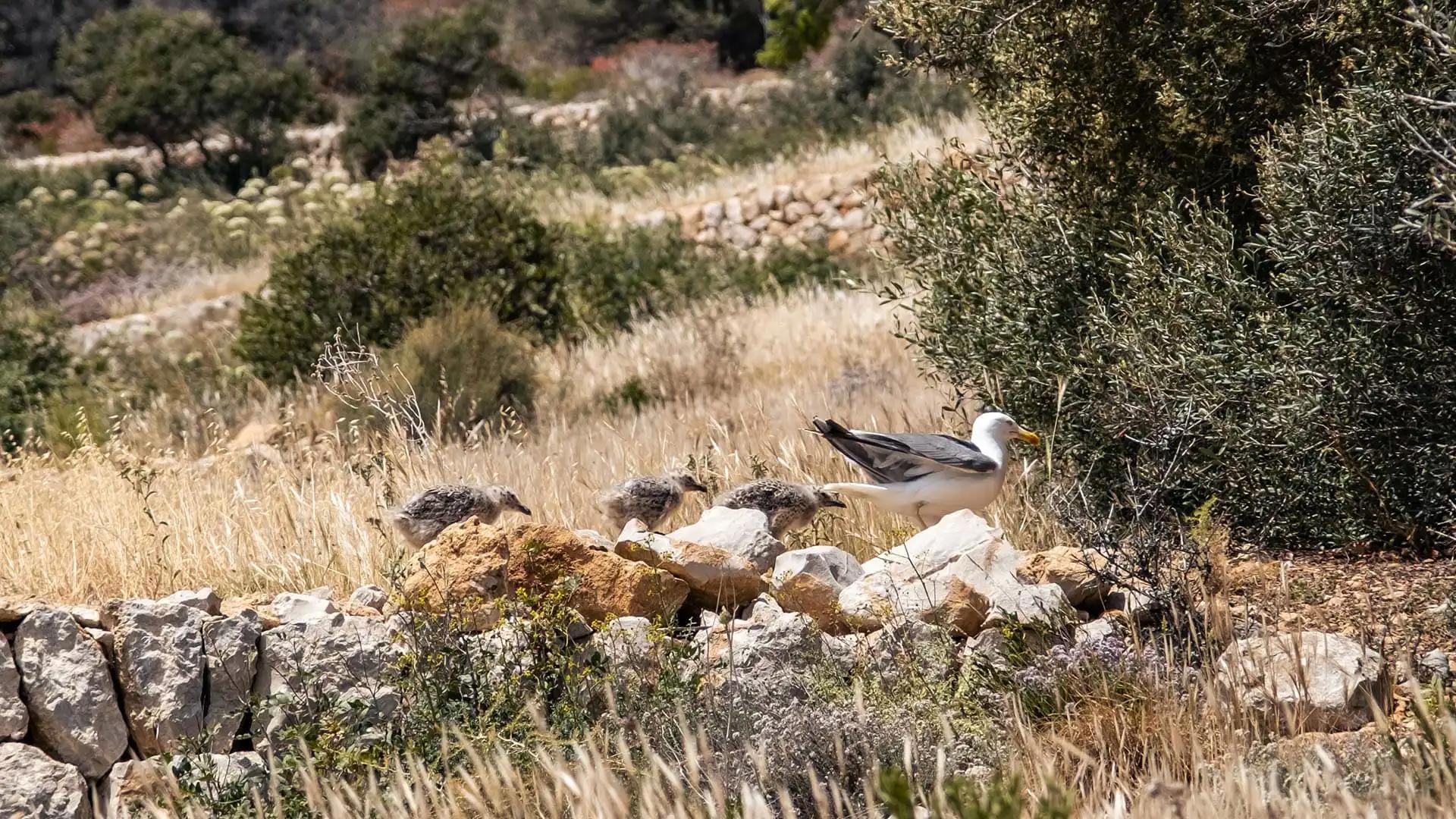
Visiting Sant Elm
Once back on the island of Majorca in the late afternoon, we enjoyed the sun by eating an ice cream on the coast of the town of Sant Elm. This small, very welcoming resort offers many shops and restaurants often offering a magnificent view of the Majorcan coast and the island of Sa Dragonera.
Our good addresses in Sant Elm
🛶 Keida : If you want to take a kayak trip.
🛥 Ferry Margarita : Connects Sant Elm and Dragonera.
🍦 Gelati telmo : For a sweet and refreshing break in the streets of Sant Elm.
Day 8 • Visiting the north of Mallorca: Torrent de Pareis, Gorg Blau & Cuber
What's magical about Mallorca is that there are things to see everywhere. That day, we went to the Torrent de Pareis in the north of the island. On the way back, we decided to get lost in the countryside by spotting two beautiful lakes with Google Earth.
Nus de Sa Corbata
To get to Sa Calobra, we leave the ma-10 at Escorca for the ma-2141. It becomes quite an adventure to go down to the seaside… This spectacular road, designed by the Italian engineer, Antonio Paretti, is composed of 12 180° turns and a 360° turn at the Nus de Sa Corbata (Cravat Knot in English). 14 km long with a 900 m elevation change, the ma-2141 offers incredible views throughout our descent. The road even goes through the rock at one point.
Don't hesitate to stop at the Sa Corbata viewpoint to enjoy the view on both sides of the valley. There is even a small tavern to cool off 😉
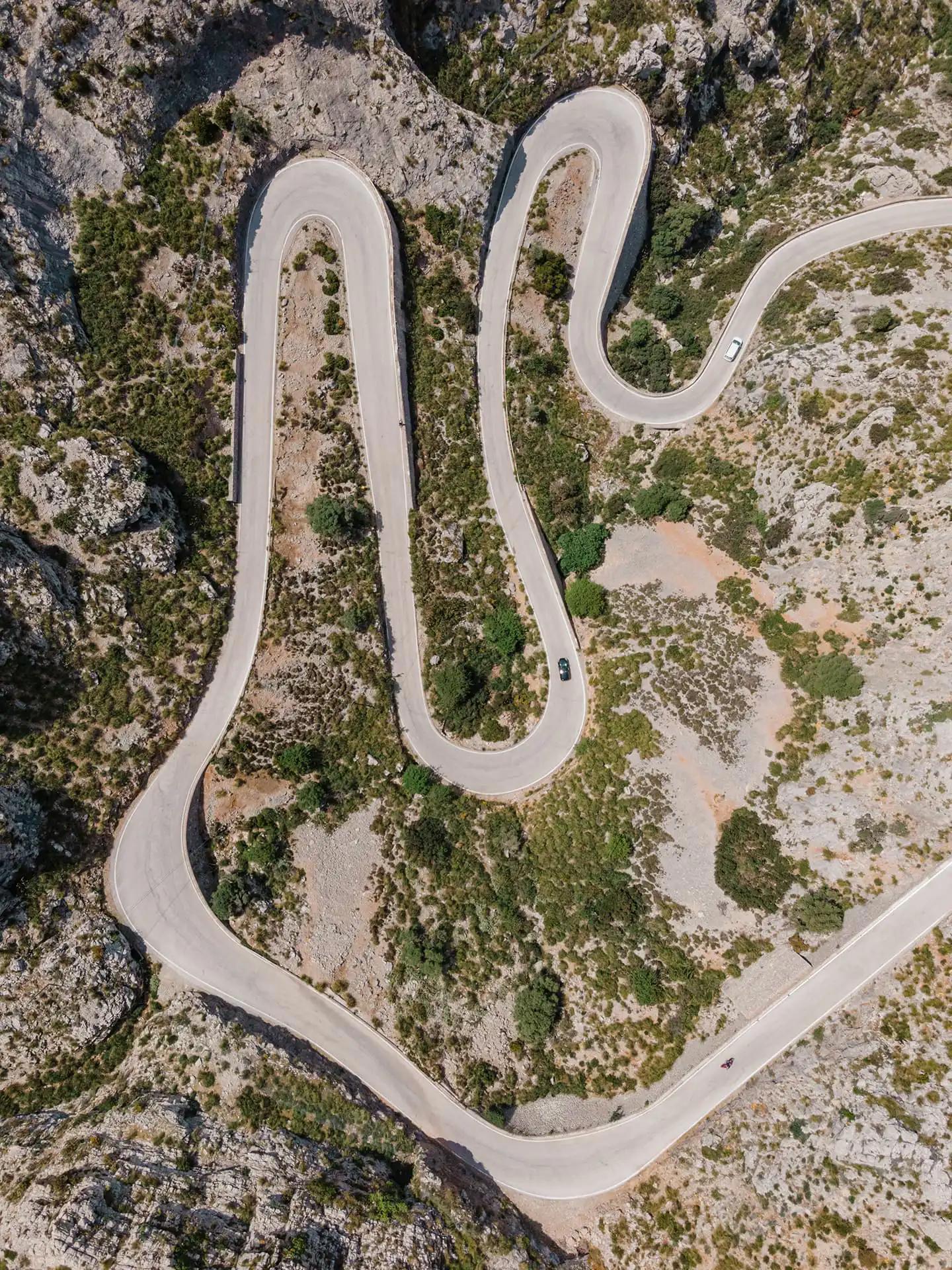
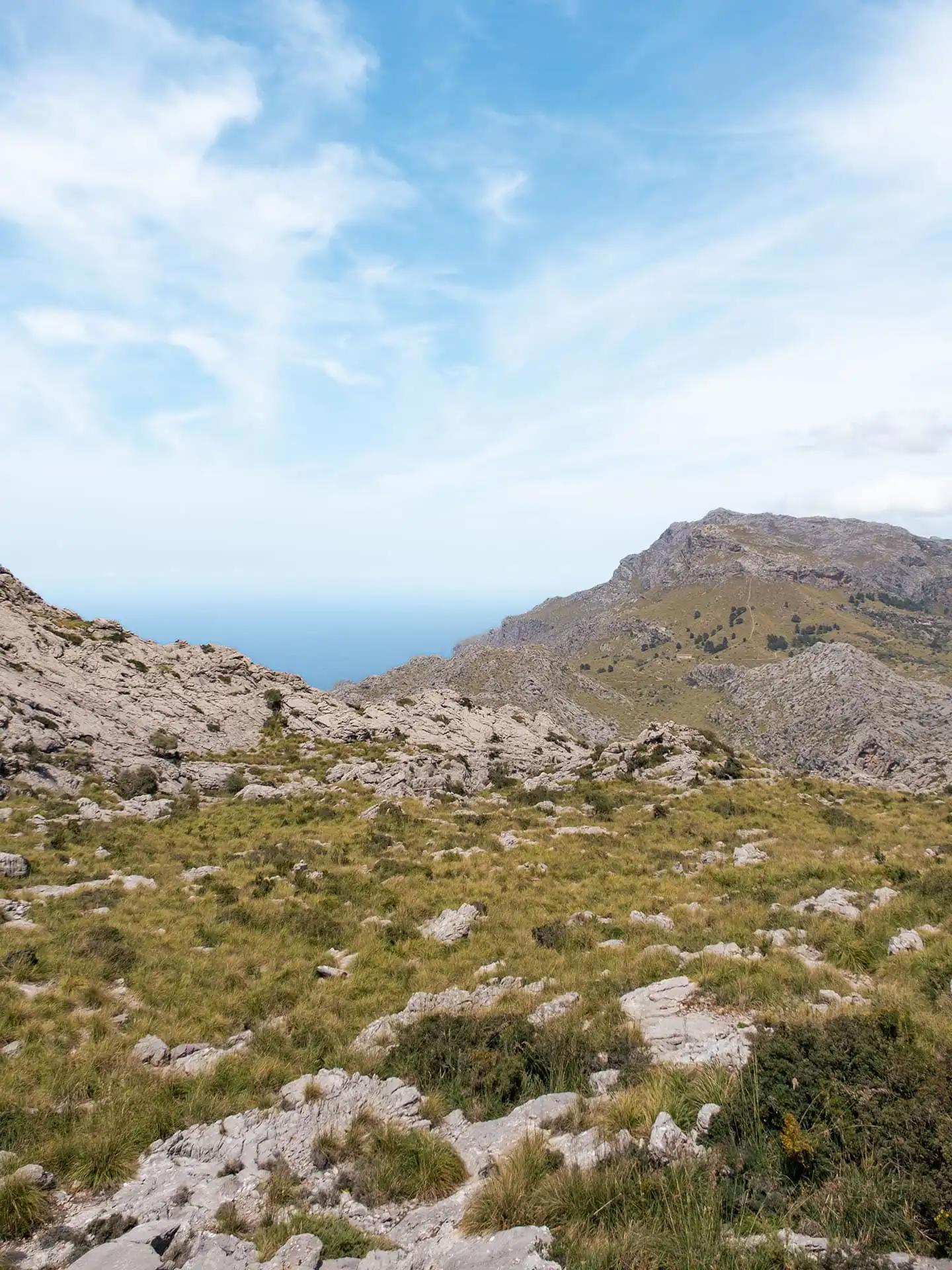
Torrent de Pareis / Sa Calobra

Sa Calobra beach marks the spot where the Torrent de Pareis flows into the sea between two majestic cliffs. During the dry season, you can easily walk through the canyon carved by the Torrent de Lluc and Torrent de Gorg Blau. A must-see place that we recommend you add to your list during a stay in Majorca (even if the parking is a bit expensive to our taste 😉)
For more information on Sa Calobra, we recommend visiting the article on our Top 5 of the most beautiful beaches in Majorca.
Gorg Blau Reservoir
After our stop at Torrent de Pareis, we continue on the MA-10 towards Sóller. A few kilometers from Escorca, we come across the beautiful expanse of water of Gorg Blau along the road. This turquoise water reservoir nestled in the heart of the Serra de Tramuntana, lives up to its name: Gorg Blau means "blue pool" in French.
Despite its very natural appearance, the Gorg blau reservoir is one of the 2 Majorcan dam lakes born in the 1970s.
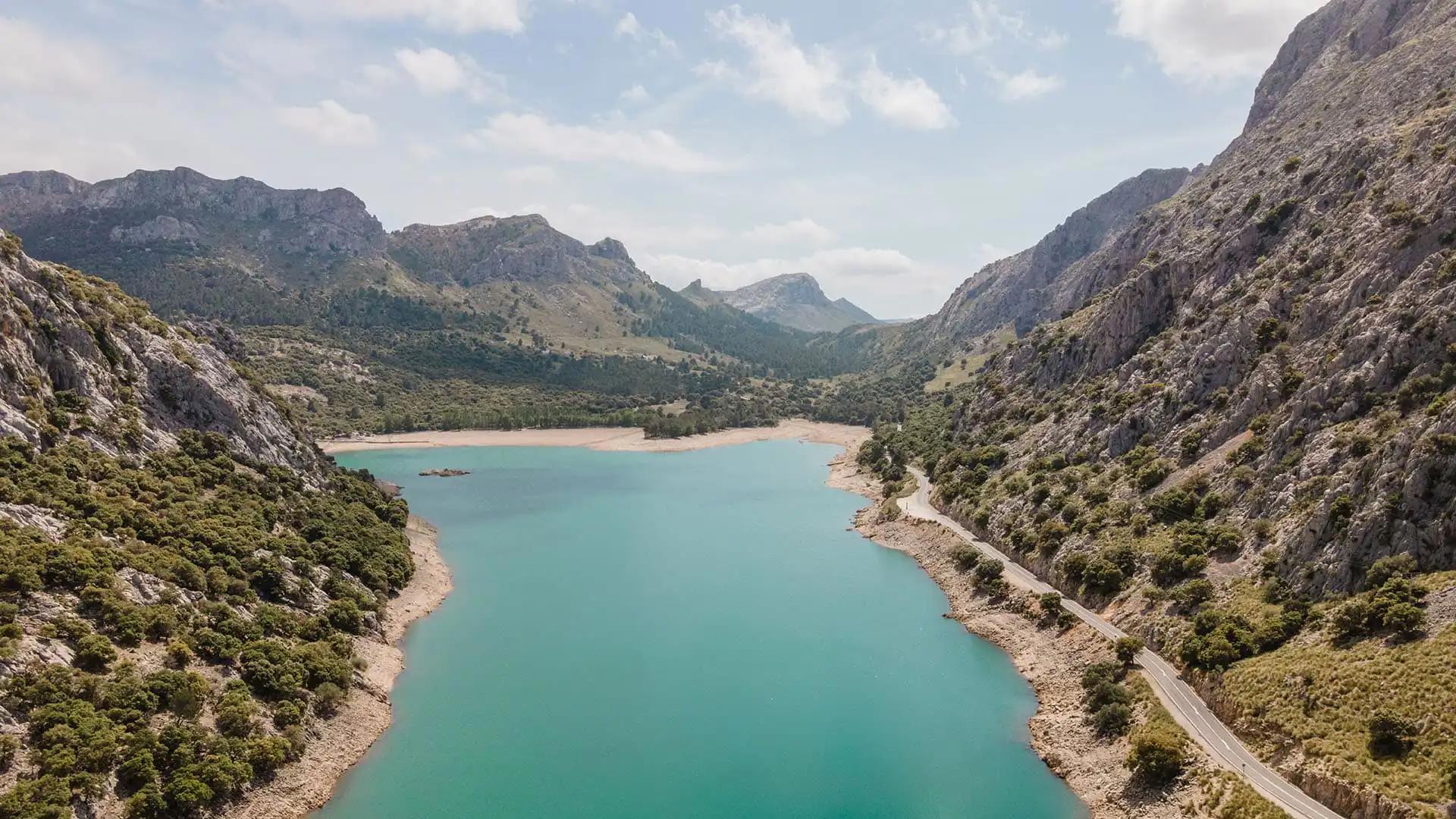
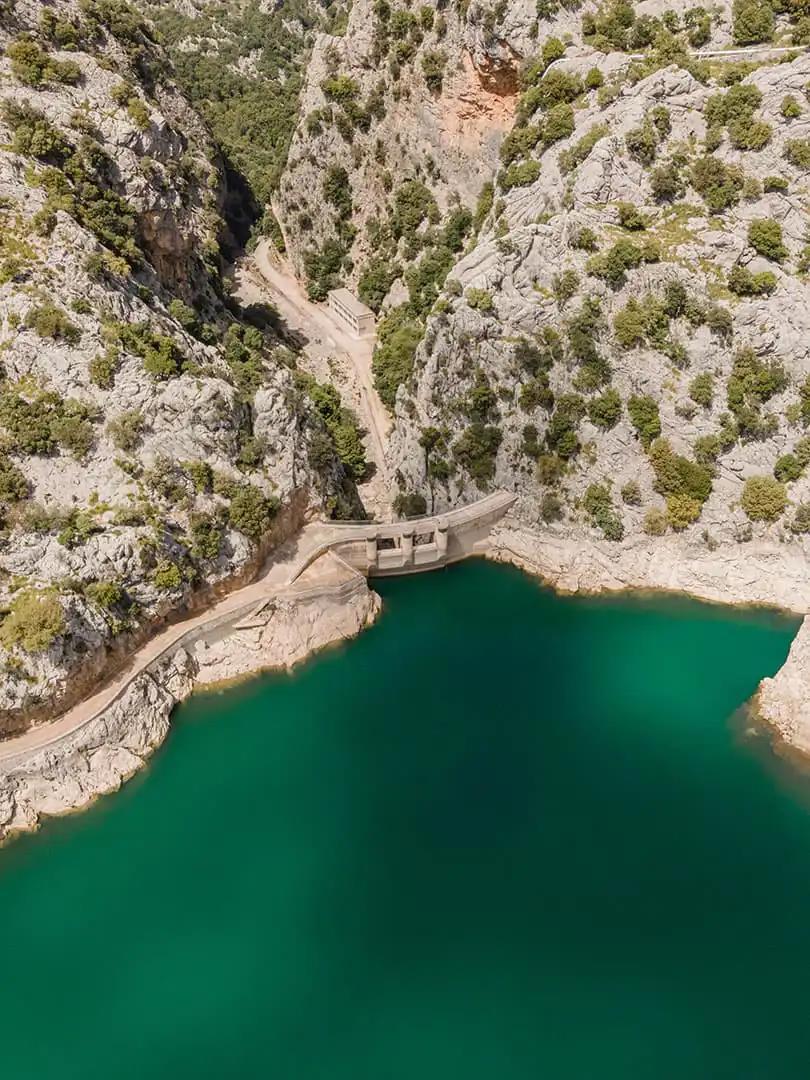
Practical information
Photo Spot 📸 • There are several stops along the road to admire the scenery. Our favorite is the one on the small parking lot next to the tunnel, here is its Google Maps location.
Cúber Reservoir
Back on the road, it takes us only 10 short minutes to drive between Gorg Blau and Cúber. Several parking areas are located along the road, allowing us to stop. Once past the small barrier (yes, the Lake Cúber is a nature reserve), we find ourselves facing an incredible sight: a turquoise expanse of water, stunning nature with the yellow hues of flowers and the green of the trees, a herd of free-roaming goats, all at the foot of Puig Major and in the heart of the Serra de Tramuntana.
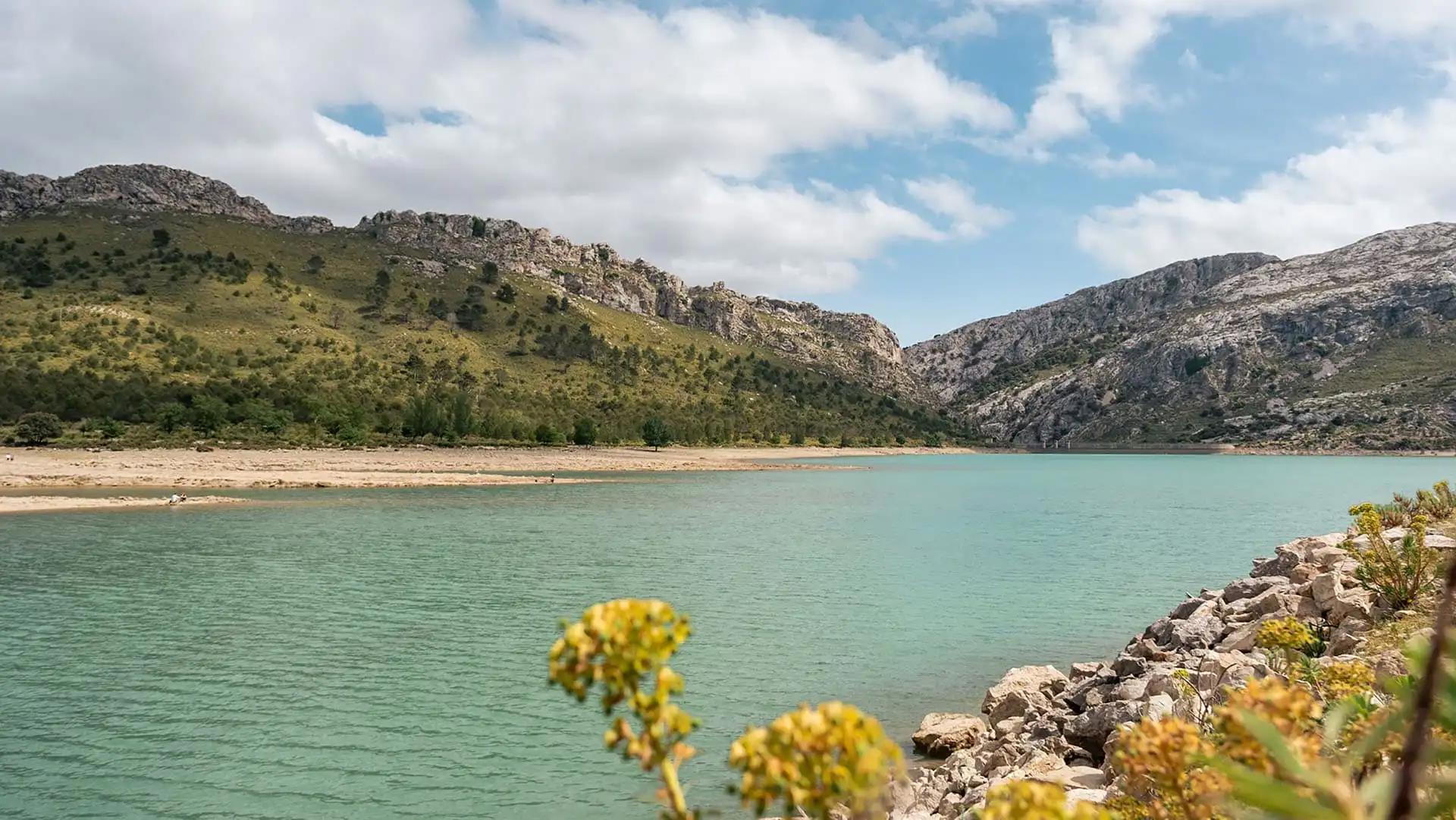
We can't resist walking around the lake to see it from all angles. For this very accessible 5km hike, you should allow a little over an hour.
Just like Gorg Blau, Cúber is an artificial reservoir lake. They are an important source of drinking water that supplies the city of Palma a few tens of kilometers further down.
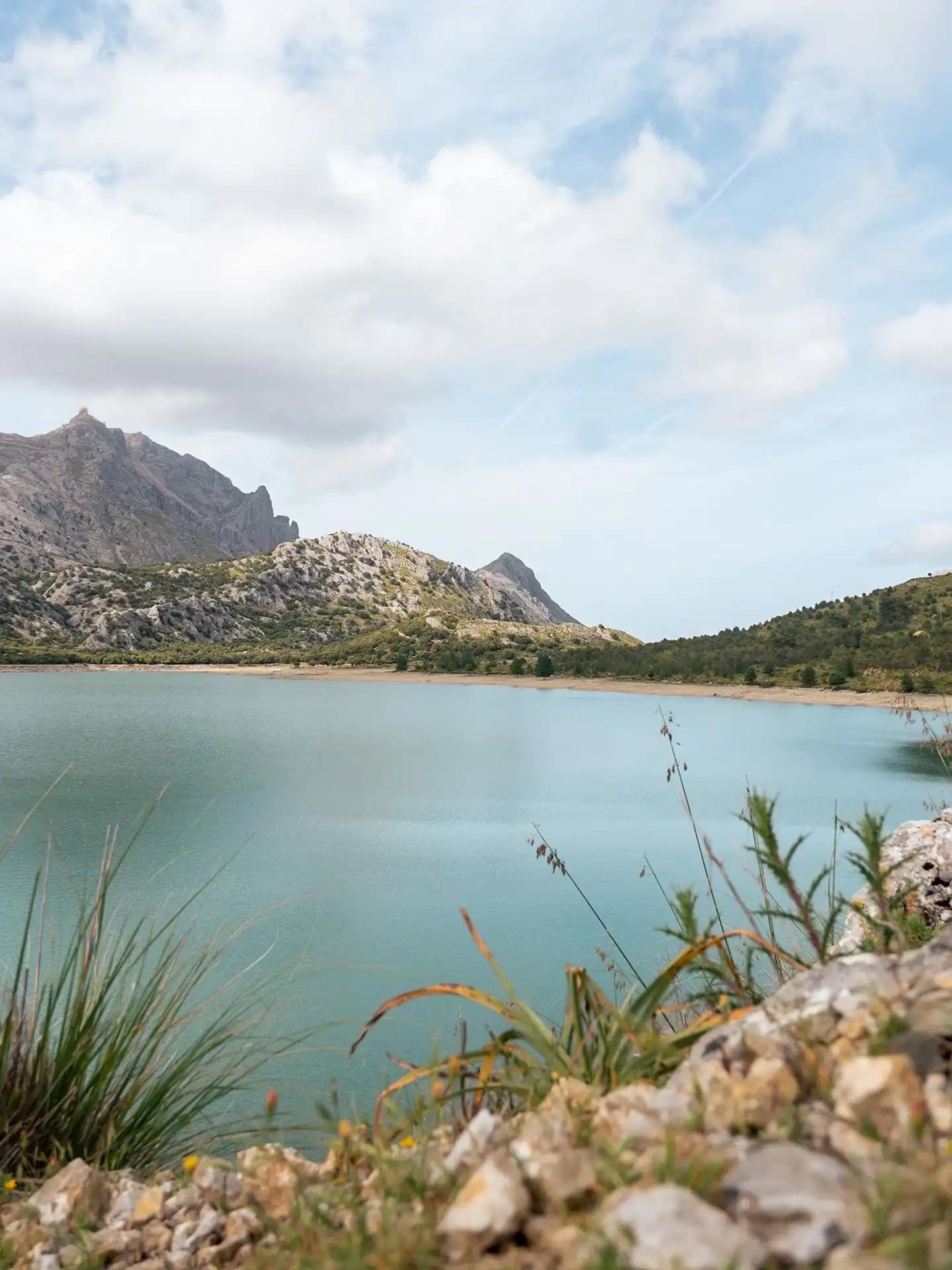
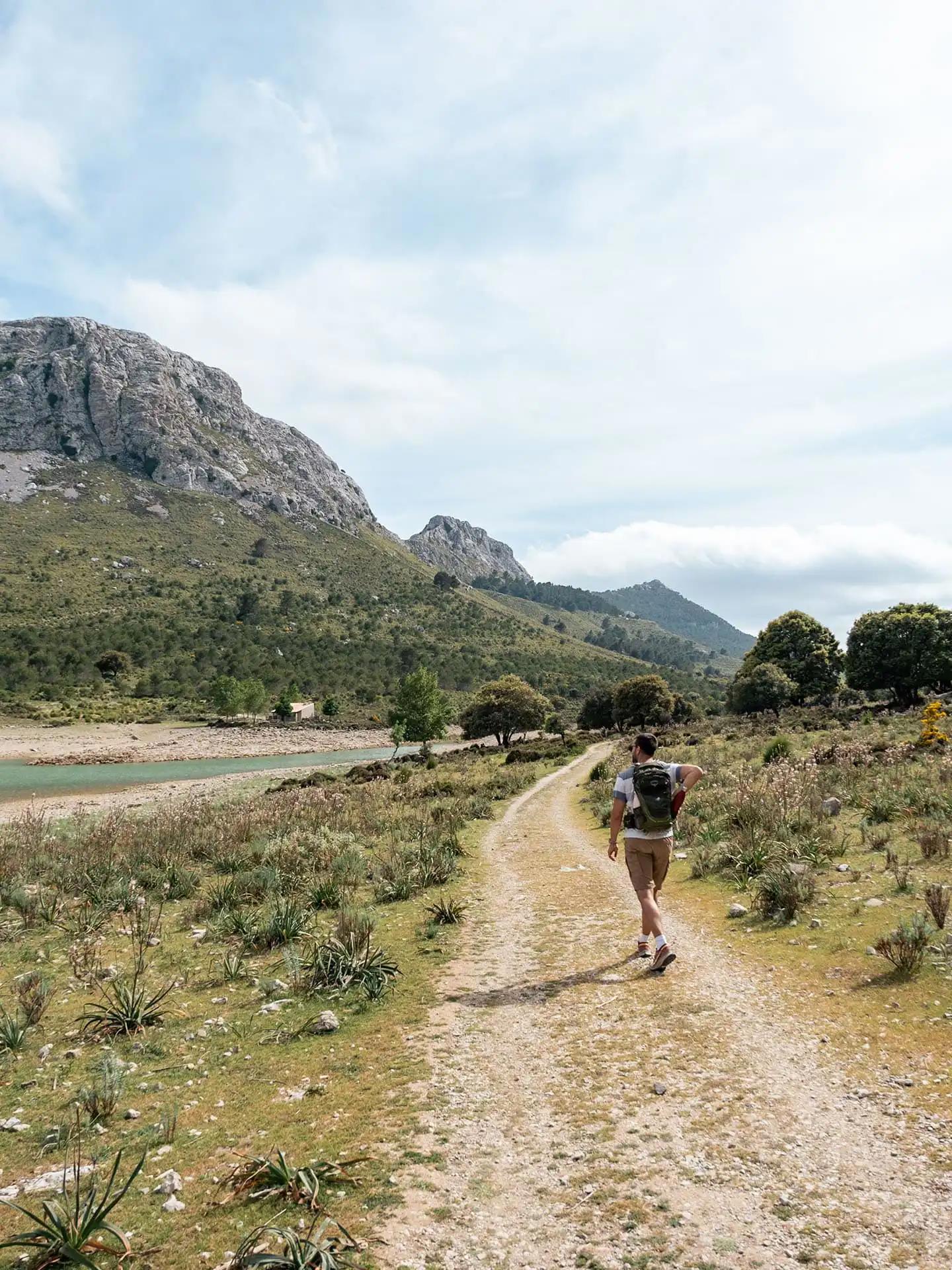
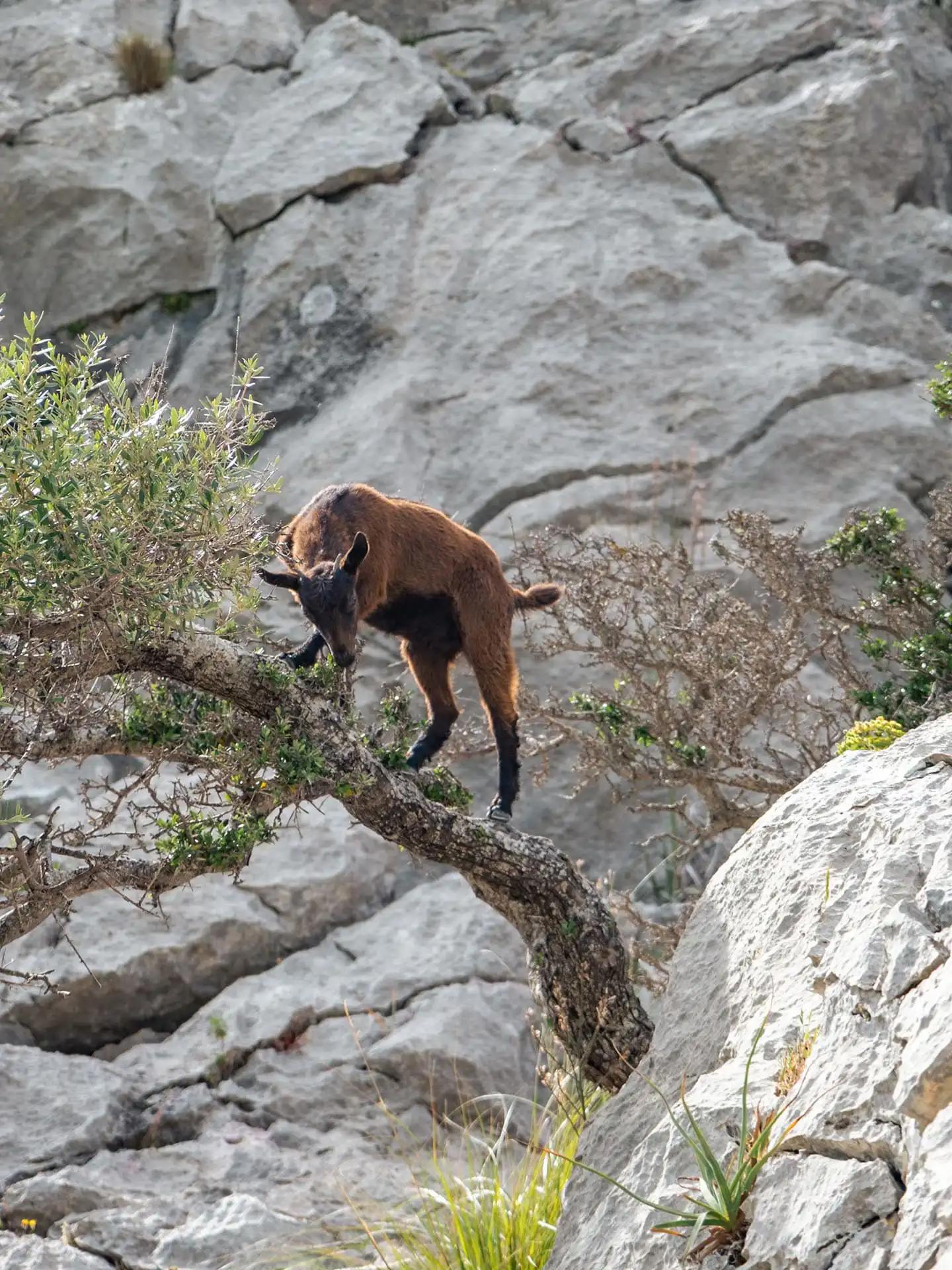
Practical information
Parking • There are 2 parking areas near the Cùber reservoir: a small parking area at the entrance and a large parking area a little further.
Unfortunately, we won't have time to continue our journey to Sóller. A charming Spanish village that has been recommended to us several times. This will be an opportunity for us to return to Majorca 🤩
Day 9 • The fortified old town of Alcudià & the cultural heritage of Artà
Last wake-up on the island of Majorca in the heart of the Balearic Islands. Our return to Belgium is drawing near and the weather is already putting us in the mood: the sky is grey and threatening.
Alcudia
Besides being known for its beaches and port, Alcudià is undoubtedly one of the oldest towns in Majorca. It consists of 2 parts: the bay and the port of Alcudià which are very touristy with beaches, restaurants and restaurants; then the old town with its history, ramparts and period houses.



The inner city center of the old town of Alcudia is pleasant for strolling and discovering the ochre or colorful houses' alleyways. It is also market day (perhaps that's why the center is pedestrianized), we take advantage of it to do some souvenir shopping with local products. The continuation of our tour takes us to the Church of Sant Jaume (Saint James in French), with its magnificent stone rose window with colorful stained glass.
We then gain some height by walking the ramparts which bear witness to the city's history.


Arta
The second stop of our day is the authentic town of Artà. Despite the weather not improving, we park the car and set off to discover Artà.
Located in a basin in the northeast of the island and in the heart of agricultural land, the town of Artà is dominated by the Sanctuary of San Salvador, which is located atop a hill. To reach it, we had to climb over 180 steps. The sanctuary of San Salvador is surrounded by a wall that offers a 360° view of the surroundings. It has become a place of pilgrimage today.




Our stomachs remind us that it's time to eat, we walk the streets in the rain to find a nice place to have a final meal on the island. After a few minutes of wandering around the village (a Sunday and a gentle resumption after lockdown don't help), we finally find a great place where we enjoy a Sangria and homemade burgers.


Good Addresses
The Bicycle 🍷 • The place sometimes to enjoy a sangria and a homemade burger on the terrace.
Full bellies, we're back on the road to Palma airport. This is where our stay on the island of Majorca ends. We hope we've been able to take you on a journey through this article and make you discover places off the beaten track. If you have any other questions about Majorca, don't hesitate to write to us in the comments, by email or via our social networks ❤️
Practical Information
How to get to Majorca?
We departed with TUI by plane from Brussels-Zaventem to Palma de Mallorca airport. The journey takes less than 2 hours by flight.
How to rent a car?
Initially, we had decided to rent a car from a well-known company on the island of Mallorca, however, the period and circumstances due to COVID-19 caused rental prices to skyrocket (up to 5 times the usual price). We therefore decided to look further and came across Terranova. A car rental company that offers more reasonable prices, mainly because they don't have a counter directly at the airport, but a person greets you at the information point of the "public" parking lot to hand over your car parked in the same parking lot.
Traveling during Covid, what are the conditions?
Health conditions change frequently. When we left, we needed to show a negative PCR test result and complete the Spanish Health Form for our return to Belgium. We only had to complete the Belgian Health Form because Majorca was in the orange zone. We advise you to check the entry conditions for Spain just before your departure. You can find the entry information on the Spanish government website and for return conditions, you should refer to those of your country of origin.
What budget for traveling to Mallorca?
The budget depends on how you travel and what activities you plan. To give you an idea, here's the budget for our 10 days in Mallorca:
✈️ Flights Brussels - Palma de Mallorca: €260 per person
🚗 Rental car: €289 for 9 days
⛽️ Fuel budget: €140 for over 1000 km
🛌 Accommodation: €675 for 8 nights (approximately €80 per night for 2 people)
🍔 Restaurant: €40 on average for 1 meal for 2 people
Add to this the groceries for lunches, breakfasts, and evenings without a restaurant; activities (e.g., €30 for 2 for the ferry to Sa Dragonera); and extras (e.g., a drink in Palma, Valldemossa), etc. We're looking at a budget of approximately €1,000 per person.
Note that flight and car rental prices can vary depending on the time of year and demand. And especially for rentals, the more people, the less the accommodation will cost.
What is the best time to go to Mallorca?
Majorca benefits from the Mediterranean climate and with its 300 days of sunshine per year, the island enjoys a mild and dry climate. The beautiful season extends from April to October with July and August as the hottest but also the most crowded months. We advise you to travel outside of school holidays to benefit from lower prices. For us, the months of May, June, September, and October are among the best times to visit Majorca.
For our part, we left mid-May and we only had one day of rain during our 10 days there. We bathed in the sea almost every day, even if it was sometimes a bit cool. The temperature of the sea is around 20° for May.

0 comment